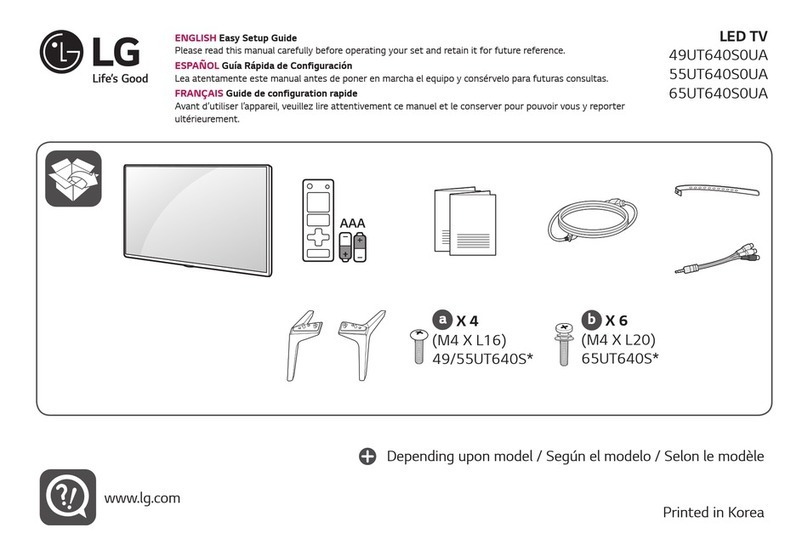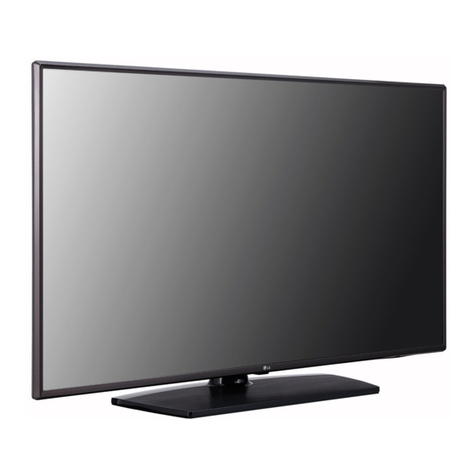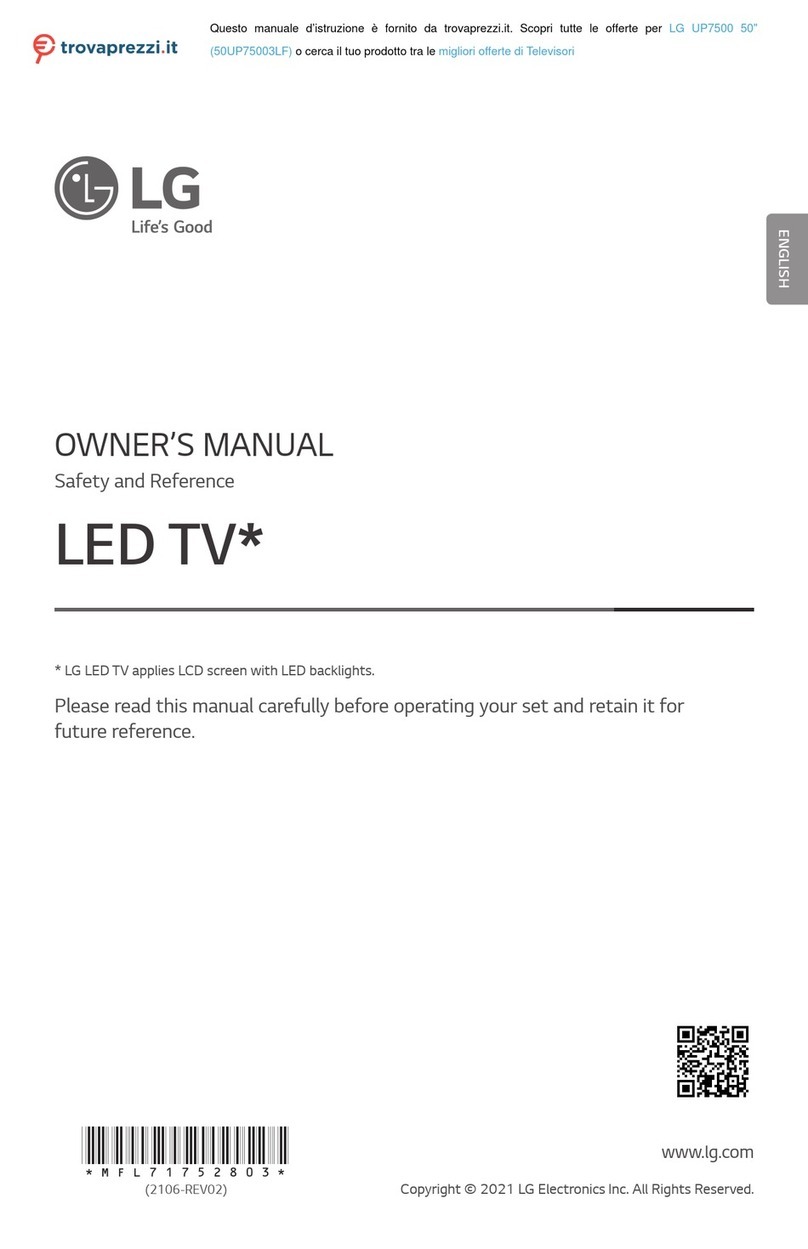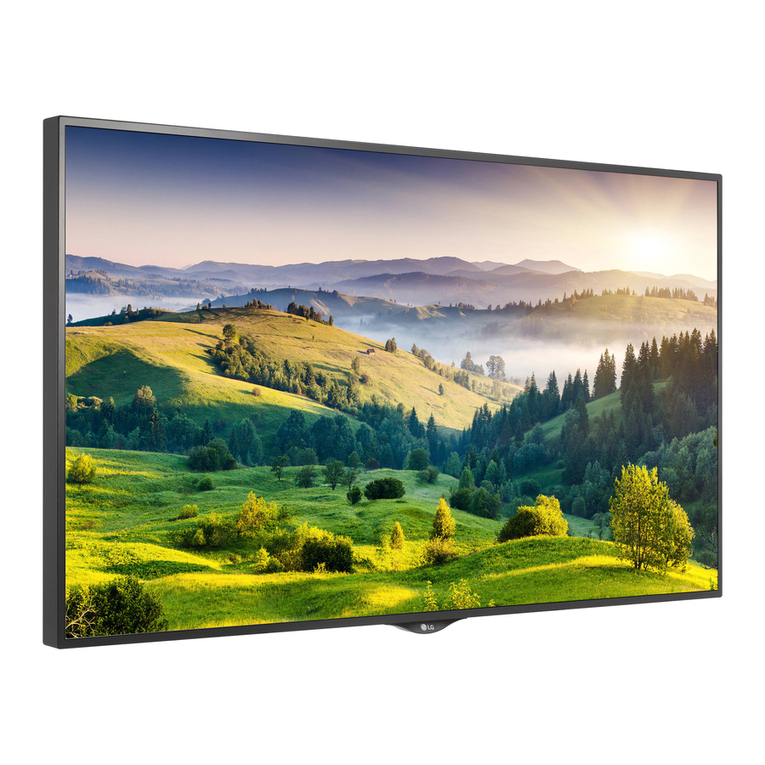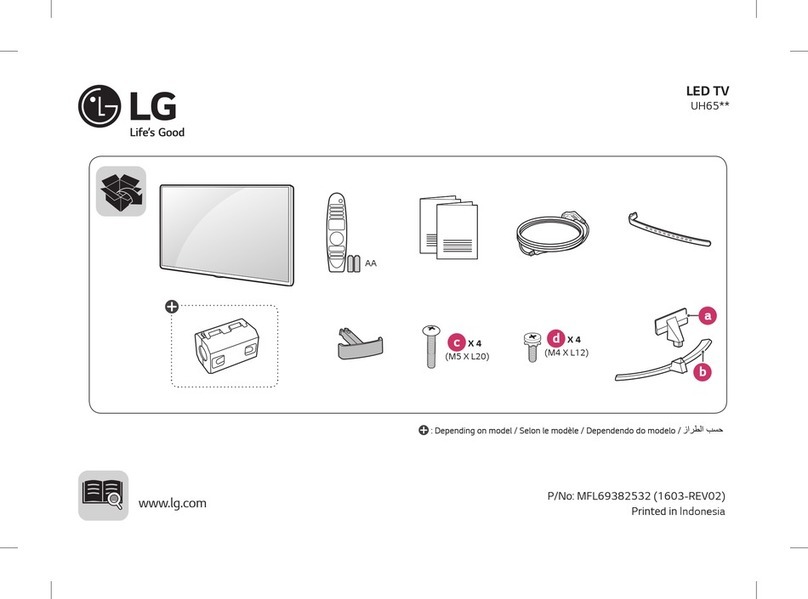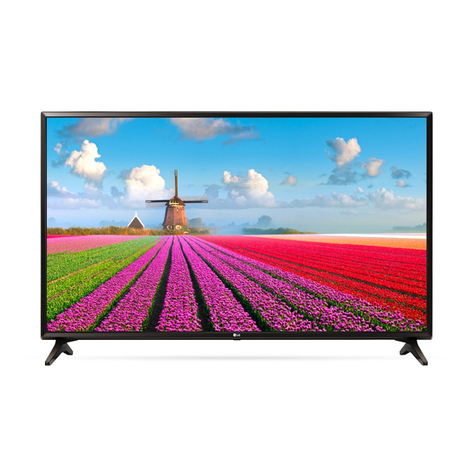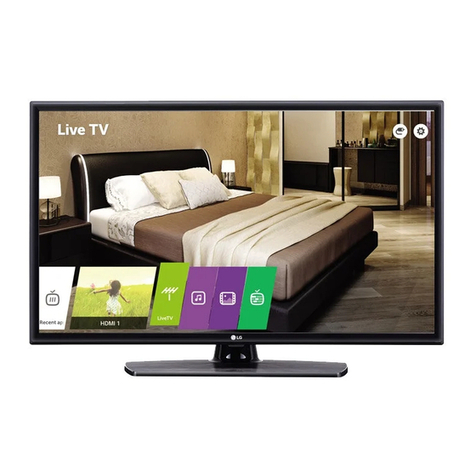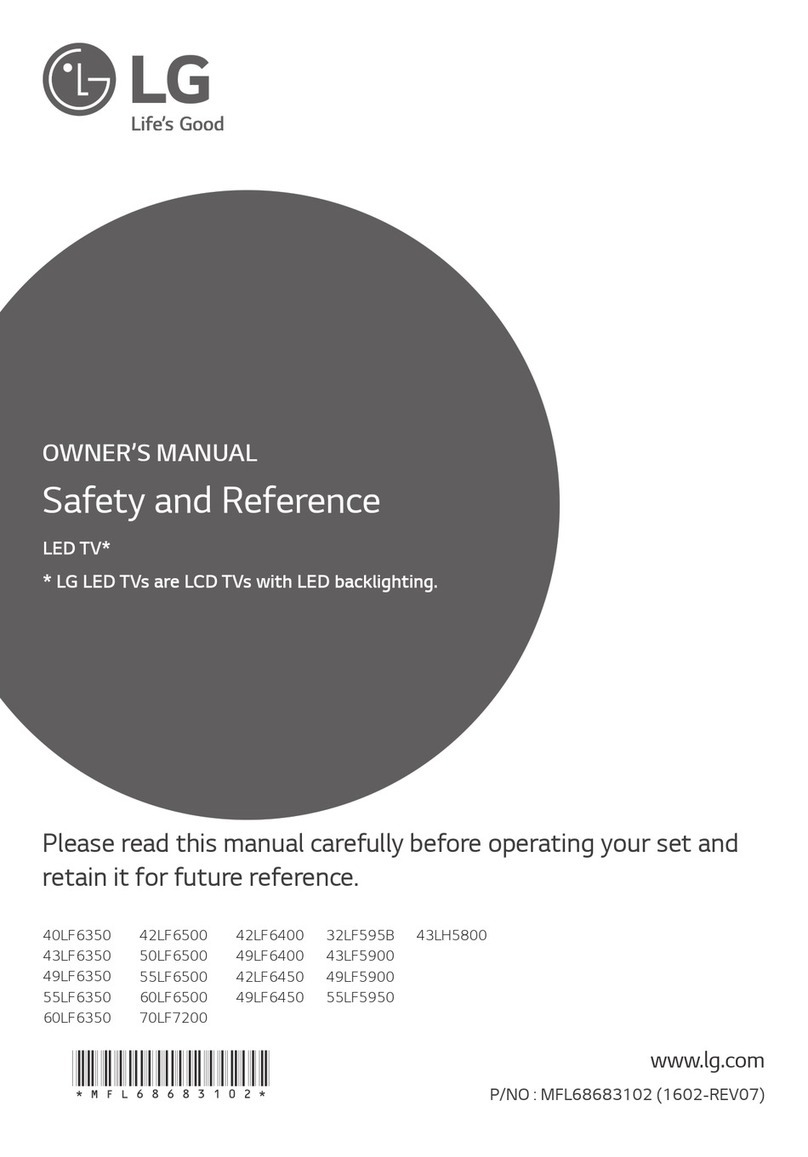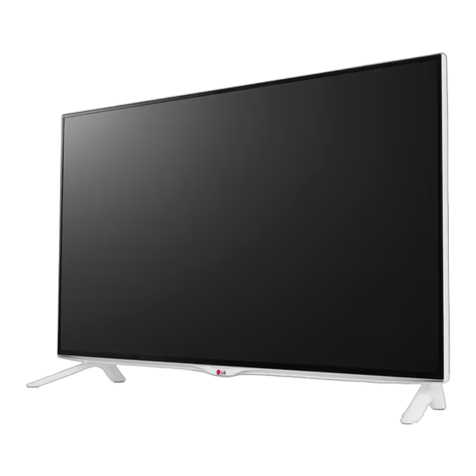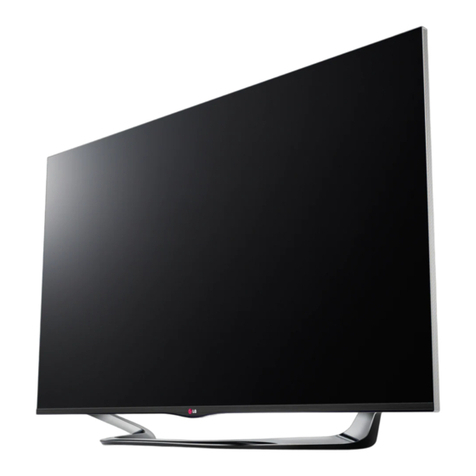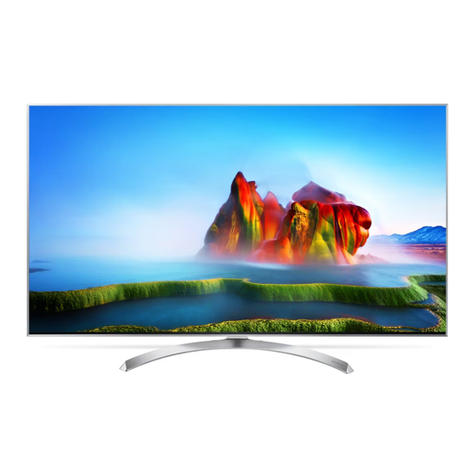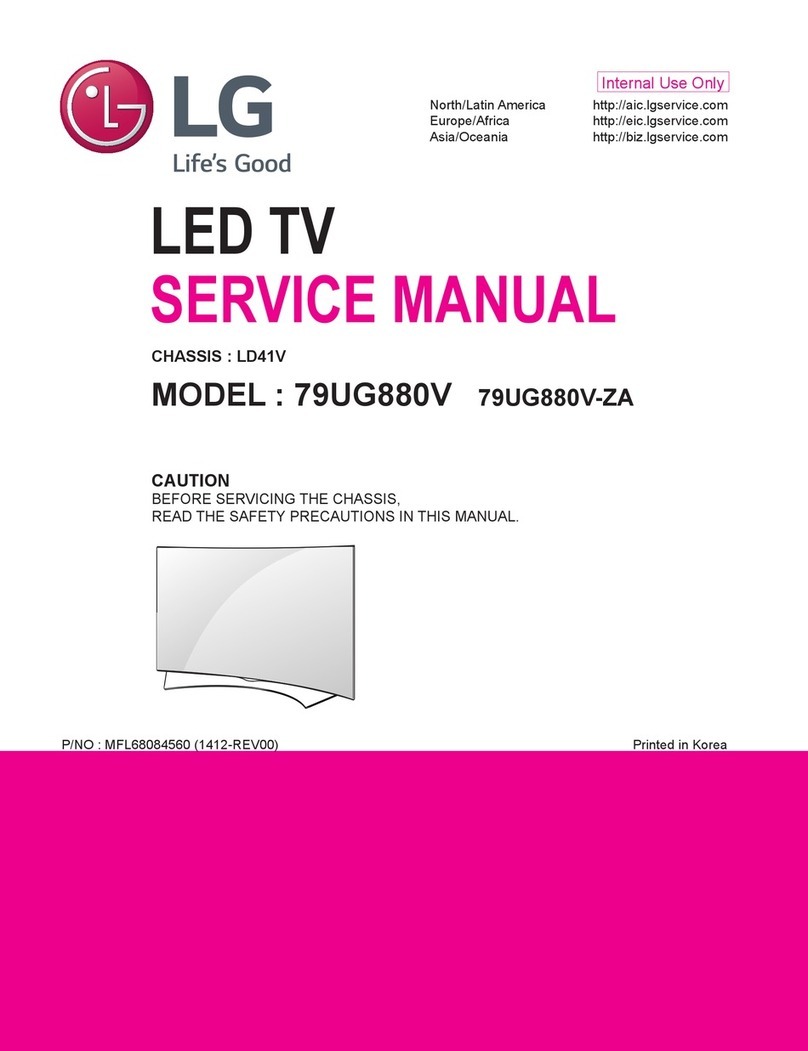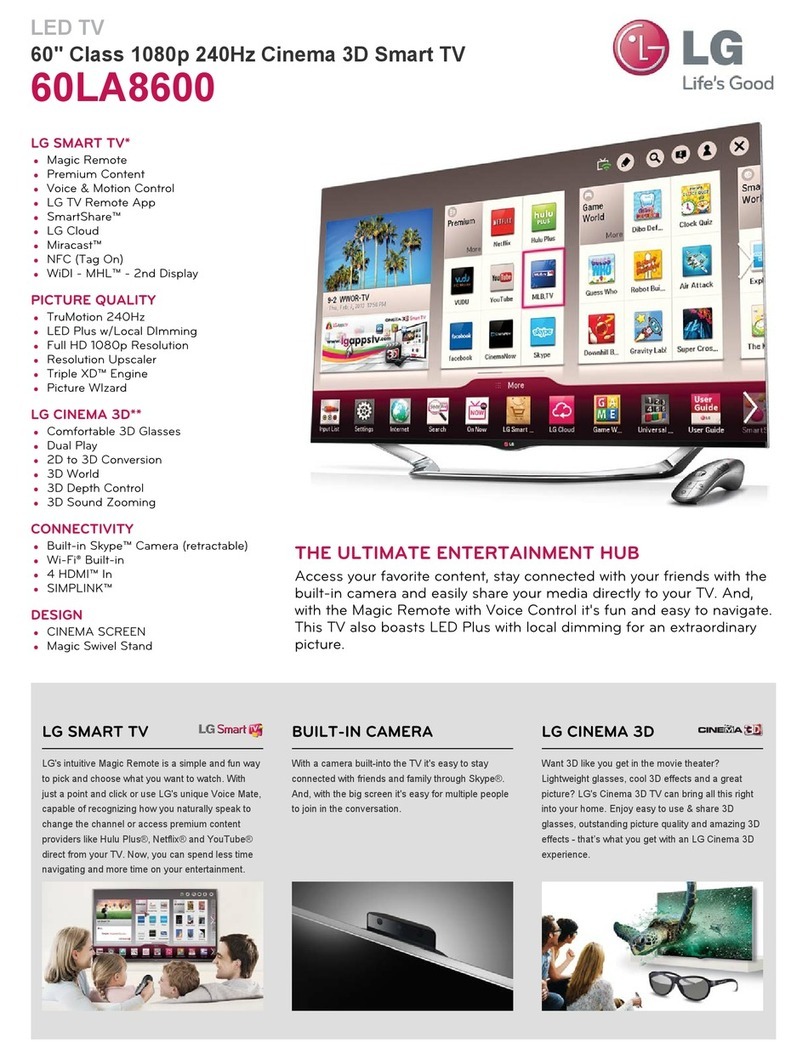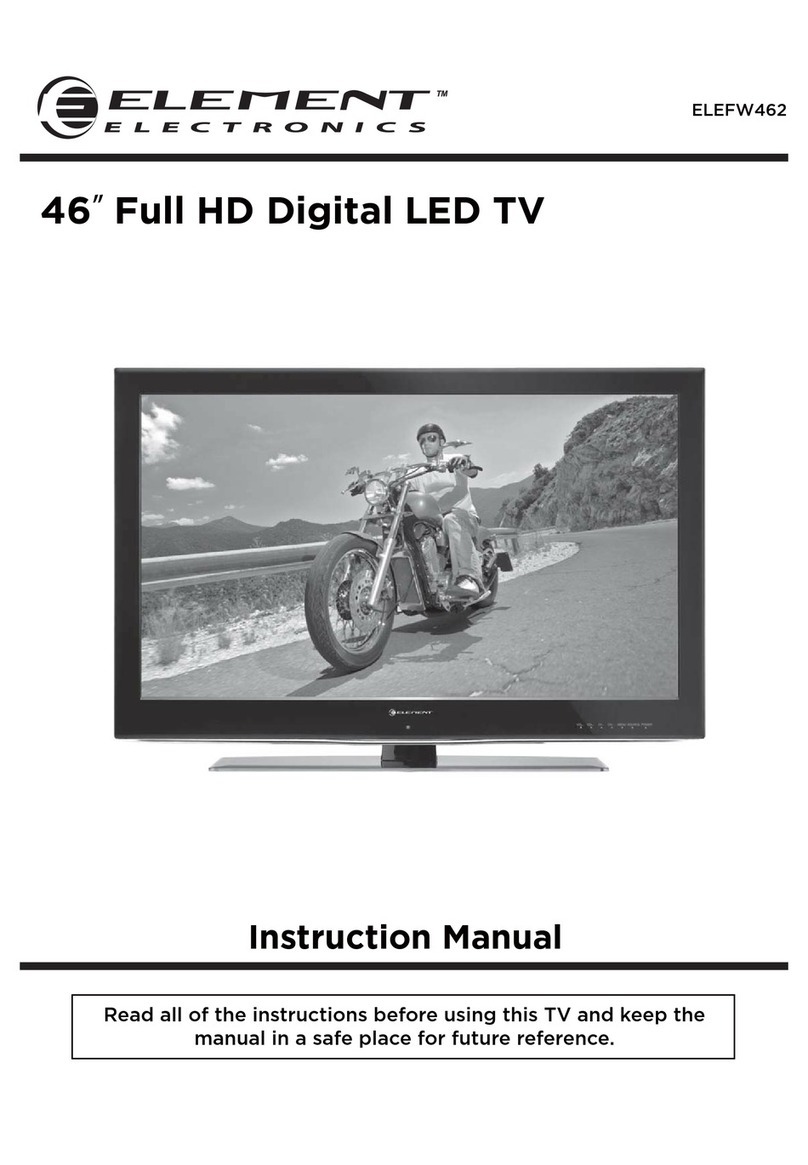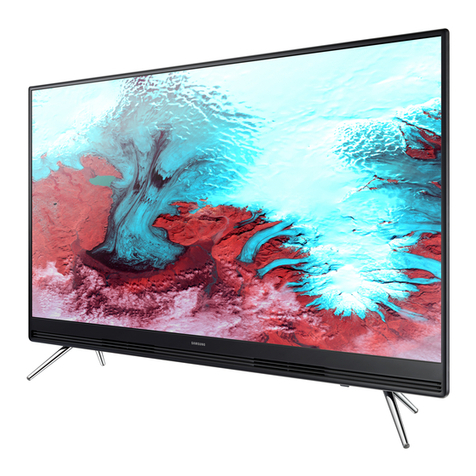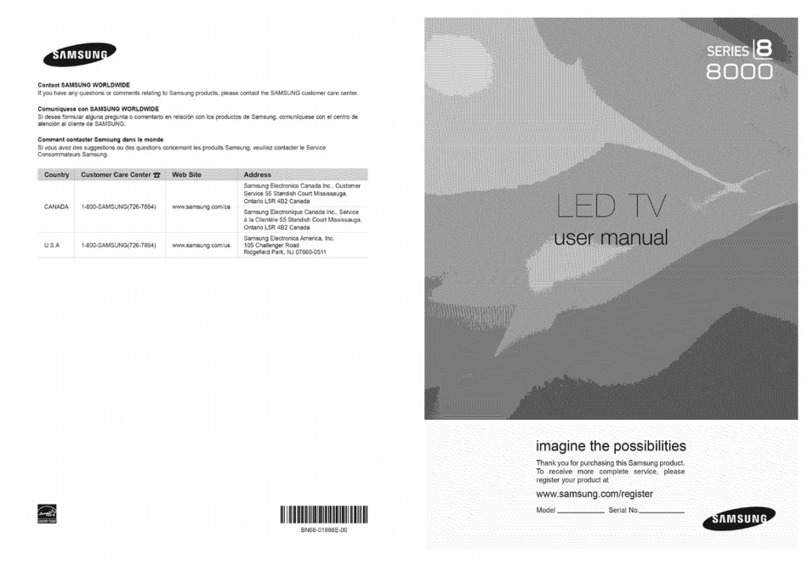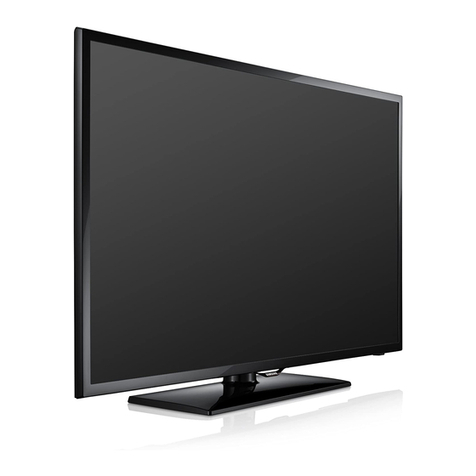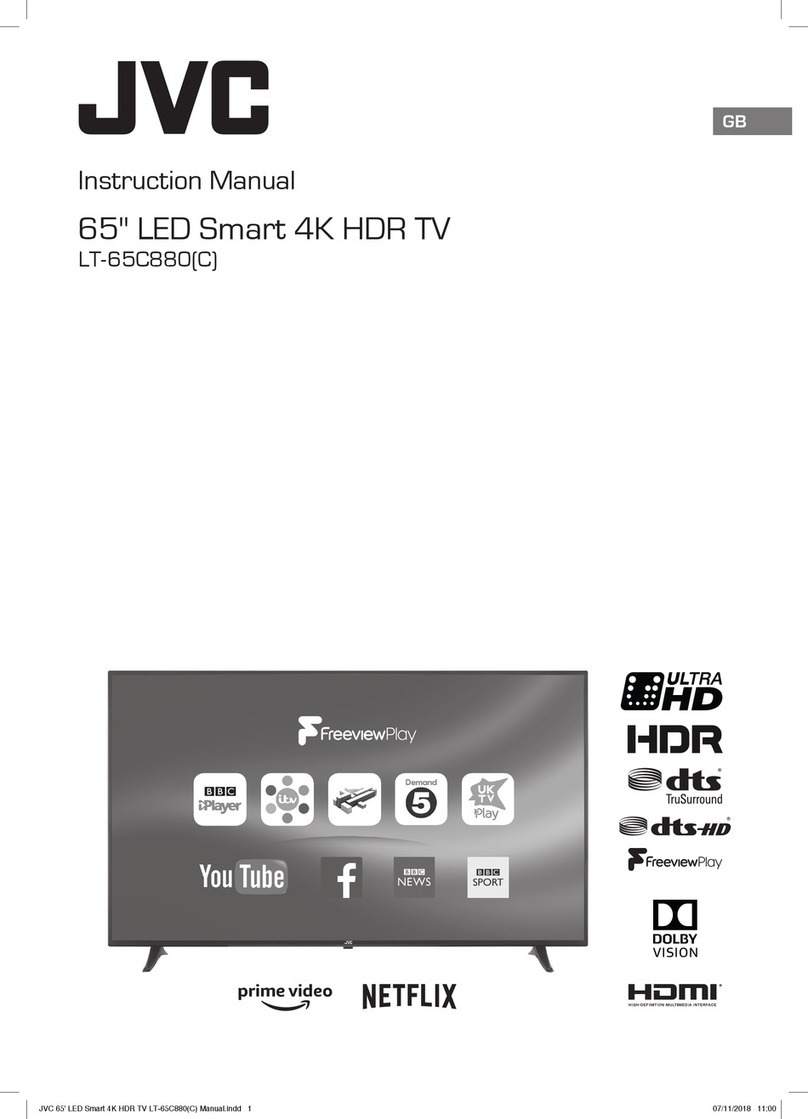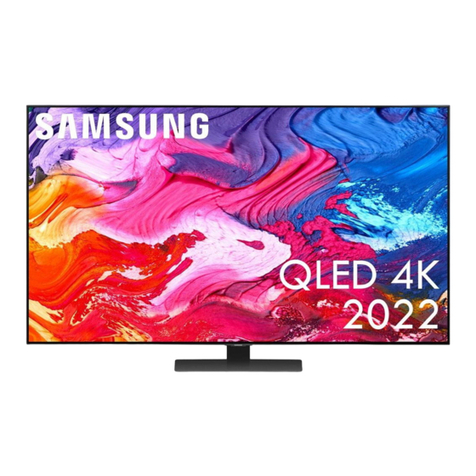LG 47LB5820 User manual

Printed in KoreaP/NO : MFL68100601 (1402-REV00)
CHASSIS : LB46B
MODEL : 47LB5820/582T/582Y
47LB5820/582T/582Y-TB
CAUTION
BEFORE SERVICING THE CHASSIS,
READ THE SAFETY PRECAUTIONS IN THIS MANUAL.
LED TV
SERVICE MANUAL
North/Latin America http://aic.lgservice.com
Europe/Africa http://eic.lgservice.com
Asia/Oceania http://biz.lgservice.com
Internal Use Only

- 2 - LGE Internal Use OnlyCopyright © LG Electronics. Inc. All rights reserved.
Only for training and service purposes
CONTENTS
CONTENTS .............................................................................................. 2
SAFETY PRECAUTIONS ........................................................................ 3
SERVICING PRECAUTIONS .................................................................... 4
SPECIFICATION ....................................................................................... 6
ADJUSTMENT INSTRUCTION ................................................................ 9
BLOCK DIAGRAM ................................................................................. 17
EXPLODED VIEW .................................................................................. 18
SCHEMATIC CIRCUIT DIAGRAM ..............................................................

- 3 - LGE Internal Use OnlyCopyright © LG Electronics. Inc. All rights reserved.
Only for training and service purposes
Many electrical and mechanical parts in this chassis have special safety-related characteristics. These parts are identified by in the
Schematic Diagram and Exploded View.
It is essential that these special safety parts should be replaced with the same components as recommended in this manual to prevent
Shock, Fire, or other Hazards.
Do not modify the original design without permission of manufacturer.
General Guidance
An isolation Transformer should always be used during the
servicing of a receiver whose chassis is not isolated from the AC
power line. Use a transformer of adequate power rating as this
protects the technician from accidents resulting in personal injury
from electrical shocks.
It will also protect the receiver and it's components from being
damaged by accidental shorts of the circuitry that may be
inadvertently introduced during the service operation.
If any fuse (or Fusible Resistor) in this TV receiver is blown,
replace it with the specified.
When replacing a high wattage resistor (Oxide Metal Film Resistor,
over 1 W), keep the resistor 10 mm away from PCB.
Keep wires away from high voltage or high temperature parts.
Before returning the receiver to the customer,
always perform an AC leakage current check on the exposed
metallic parts of the cabinet, such as antennas, terminals, etc., to
be sure the set is safe to operate without damage of electrical
shock.
Leakage Current Cold Check(Antenna Cold Check)
With the instrument AC plug removed from AC source, connect an
electrical jumper across the two AC plug prongs. Place the AC
switch in the on position, connect one lead of ohm-meter to the AC
plug prongs tied together and touch other ohm-meter lead in turn to
each exposed metallic parts such as antenna terminals, phone
jacks, etc.
If the exposed metallic part has a return path to the chassis, the
measured resistance should be between 1 MΩ and 5.2 MΩ.
When the exposed metal has no return path to the chassis the
reading must be infinite.
An other abnormality exists that must be corrected before the
receiver is returned to the customer.
Leakage Current Hot Check (See below Figure)
Plug the AC cord directly into the AC outlet.
Do not use a line Isolation Transformer during this check.
Connect 1.5 K / 10 watt resistor in parallel with a 0.15 uF capacitor
between a known good earth ground (Water Pipe, Conduit, etc.)
and the exposed metallic parts.
Measure the AC voltage across the resistor using AC voltmeter
with 1000 ohms/volt or more sensitivity.
Reverse plug the AC cord into the AC outlet and repeat AC voltage
measurements for each exposed metallic part. Any voltage
measured must not exceed 0.75 volt RMS which is corresponds to
0.5 mA.
In case any measurement is out of the limits specified, there is
possibility of shock hazard and the set must be checked and
repaired before it is returned to the customer.
Leakage Current Hot Check circuit
IMPORTANT SAFETY NOTICE
SAFETY PRECAUTIONS

- 4 - LGE Internal Use OnlyCopyright © LG Electronics. Inc. All rights reserved.
Only for training and service purposes
SERVICING PRECAUTIONS
CAUTION: Before servicing receivers covered by this service
manual and its supplements and addenda, read and follow the
SAFETY PRECAUTIONS on page 3 of this publication.
NOTE: If unforeseen circumstances create conict between the
following servicing precautions and any of the safety precautions
on page 3 of this publication, always follow the safety precau-
tions. Remember: Safety First.
General Servicing Precautions
1. Always unplug the receiver AC power cord from the AC power
source before;
a. Removing or reinstalling any component, circuit board
module or any other receiver assembly.
b. Disconnecting or reconnecting any receiver electrical plug
or other electrical connection.
c. Connecting a test substitute in parallel with an electrolytic
capacitor in the receiver.
CAUTION: A wrong part substitution or incorrect polarity
installation of electrolytic capacitors may result in an explo-
sion hazard.
2. Test high voltage only by measuring it with an appropriate
high voltage meter or other voltage measuring device (DVM,
FETVOM, etc) equipped with a suitable high voltage probe.
Do not test high voltage by "drawing an arc".
3. Do not spray chemicals on or near this receiver or any of its
assemblies.
4. Unless specied otherwise in this service manual, clean
electrical contacts only by applying the following mixture to the
contacts with a pipe cleaner, cotton-tipped stick or comparable
non-abrasive applicator; 10 % (by volume) Acetone and 90 %
(by volume) isopropyl alcohol (90 % - 99 % strength)
CAUTION: This is a ammable mixture.
Unless specied otherwise in this service manual, lubrication
of contacts in not required.
5. Do not defeat any plug/socket B+ voltage interlocks with which
receivers covered by this service manual might be equipped.
6. Do not apply AC power to this instrument and/or any of its
electrical assemblies unless all solid-state device heat sinks
are correctly installed.
7. Always connect the test receiver ground lead to the receiver
chassis ground before connecting the test receiver positive
lead.
Always remove the test receiver ground lead last.
8. Use with this receiver only the test xtures specied in this
service manual.
CAUTION: Do not connect the test xture ground strap to any
heat sink in this receiver.
Electrostatically Sensitive (ES) Devices
Some semiconductor (solid-state) devices can be damaged eas-
ily by static electricity. Such components commonly are called
Electrostatically Sensitive (ES) Devices. Examples of typical ES
devices are integrated circuits and some eld-effect transistors
and semiconductor “chip” components. The following techniques
should be used to help reduce the incidence of component dam-
age caused by static by static electricity.
1. Immediately before handling any semiconductor component or
semiconductor-equipped assembly, drain off any electrostatic
charge on your body by touching a known earth ground. Alter-
natively, obtain and wear a commercially available discharg-
ing wrist strap device, which should be removed to prevent
potential shock reasons prior to applying power to the unit
under test.
2. After removing an electrical assembly equipped with ES
devices, place the assembly on a conductive surface such as
aluminum foil, to prevent electrostatic charge buildup or expo-
sure of the assembly.
3. Use only a grounded-tip soldering iron to solder or unsolder
ES devices.
4. Use only an anti-static type solder removal device. Some sol-
der removal devices not classied as “anti-static” can generate
electrical charges sufcient to damage ES devices.
5. Do not use freon-propelled chemicals. These can generate
electrical charges sufcient to damage ES devices.
6. Do not remove a replacement ES device from its protective
package until immediately before you are ready to install it.
(Most replacement ES devices are packaged with leads elec-
trically shorted together by conductive foam, aluminum foil or
comparable conductive material).
7. Immediately before removing the protective material from the
leads of a replacement ES device, touch the protective mate-
rial to the chassis or circuit assembly into which the device will
be installed.
CAUTION: Be sure no power is applied to the chassis or cir-
cuit, and observe all other safety precautions.
8. Minimize bodily motions when handling unpackaged replace-
ment ES devices. (Otherwise harmless motion such as the
brushing together of your clothes fabric or the lifting of your
foot from a carpeted oor can generate static electricity suf-
cient to damage an ES device.)
General Soldering Guidelines
1. Use a grounded-tip, low-wattage soldering iron and appropri-
ate tip size and shape that will maintain tip temperature within
the range or 500 °F to 600 °F.
2. Use an appropriate gauge of RMA resin-core solder composed
of 60 parts tin/40 parts lead.
3. Keep the soldering iron tip clean and well tinned.
4. Thoroughly clean the surfaces to be soldered. Use a mall wire-
bristle (0.5 inch, or 1.25 cm) brush with a metal handle.
Do not use freon-propelled spray-on cleaners.
5. Use the following unsoldering technique
a. Allow the soldering iron tip to reach normal temperature.
(500 °F to 600 °F)
b. Heat the component lead until the solder melts.
c. Quickly draw the melted solder with an anti-static, suction-
type solder removal device or with solder braid.
CAUTION: Work quickly to avoid overheating the circuit
board printed foil.
6. Use the following soldering technique.
a. Allow the soldering iron tip to reach a normal temperature
(500 °F to 600 °F)
b. First, hold the soldering iron tip and solder the strand
against the component lead until the solder melts.
c. Quickly move the soldering iron tip to the junction of the
component lead and the printed circuit foil, and hold it there
only until the solder ows onto and around both the compo-
nent lead and the foil.
CAUTION: Work quickly to avoid overheating the circuit
board printed foil.
d. Closely inspect the solder area and remove any excess or
splashed solder with a small wire-bristle brush.

- 5 - LGE Internal Use OnlyCopyright © LG Electronics. Inc. All rights reserved.
Only for training and service purposes
IC Remove/Replacement
Some chassis circuit boards have slotted holes (oblong) through
which the IC leads are inserted and then bent at against the cir-
cuit foil. When holes are the slotted type, the following technique
should be used to remove and replace the IC. When working with
boards using the familiar round hole, use the standard technique
as outlined in paragraphs 5 and 6 above.
Removal
1. Desolder and straighten each IC lead in one operation by
gently prying up on the lead with the soldering iron tip as the
solder melts.
2. Draw away the melted solder with an anti-static suction-type
solder removal device (or with solder braid) before removing
the IC.
Replacement
1. Carefully insert the replacement IC in the circuit board.
2. Carefully bend each IC lead against the circuit foil pad and
solder it.
3. Clean the soldered areas with a small wire-bristle brush.
(It is not necessary to reapply acrylic coating to the areas).
"Small-Signal" Discrete Transistor
Removal/Replacement
1. Remove the defective transistor by clipping its leads as close
as possible to the component body.
2. Bend into a "U" shape the end of each of three leads remain-
ing on the circuit board.
3. Bend into a "U" shape the replacement transistor leads.
4. Connect the replacement transistor leads to the corresponding
leads extending from the circuit board and crimp the "U" with
long nose pliers to insure metal to metal contact then solder
each connection.
Power Output, Transistor Device
Removal/Replacement
1. Heat and remove all solder from around the transistor leads.
2. Remove the heat sink mounting screw (if so equipped).
3. Carefully remove the transistor from the heat sink of the circuit
board.
4. Insert new transistor in the circuit board.
5. Solder each transistor lead, and clip off excess lead.
6. Replace heat sink.
Diode Removal/Replacement
1. Remove defective diode by clipping its leads as close as pos-
sible to diode body.
2. Bend the two remaining leads perpendicular y to the circuit
board.
3. Observing diode polarity, wrap each lead of the new diode
around the corresponding lead on the circuit board.
4. Securely crimp each connection and solder it.
5. Inspect (on the circuit board copper side) the solder joints of
the two "original" leads. If they are not shiny, reheat them and
if necessary, apply additional solder.
Fuse and Conventional Resistor
Removal/Replacement
1. Clip each fuse or resistor lead at top of the circuit board hollow
stake.
2. Securely crimp the leads of replacement component around
notch at stake top.
3. Solder the connections.
CAUTION: Maintain original spacing between the replaced
component and adjacent components and the circuit board to
prevent excessive component temperatures.
Circuit Board Foil Repair
Excessive heat applied to the copper foil of any printed circuit
board will weaken the adhesive that bonds the foil to the circuit
board causing the foil to separate from or "lift-off" the board. The
following guidelines and procedures should be followed when-
ever this condition is encountered.
At IC Connections
To repair a defective copper pattern at IC connections use the
following procedure to install a jumper wire on the copper pattern
side of the circuit board. (Use this technique only on IC connec-
tions).
1. Carefully remove the damaged copper pattern with a sharp
knife. (Remove only as much copper as absolutely necessary).
2. carefully scratch away the solder resist and acrylic coating (if
used) from the end of the remaining copper pattern.
3. Bend a small "U" in one end of a small gauge jumper wire and
carefully crimp it around the IC pin. Solder the IC connection.
4. Route the jumper wire along the path of the out-away copper
pattern and let it overlap the previously scraped end of the
good copper pattern. Solder the overlapped area and clip off
any excess jumper wire.
At Other Connections
Use the following technique to repair the defective copper pattern
at connections other than IC Pins. This technique involves the
installation of a jumper wire on the component side of the circuit
board.
1. Remove the defective copper pattern with a sharp knife.
Remove at least 1/4 inch of copper, to ensure that a hazardous
condition will not exist if the jumper wire opens.
2. Trace along the copper pattern from both sides of the pattern
break and locate the nearest component that is directly con-
nected to the affected copper pattern.
3. Connect insulated 20-gauge jumper wire from the lead of the
nearest component on one side of the pattern break to the
lead of the nearest component on the other side.
Carefully crimp and solder the connections.
CAUTION: Be sure the insulated jumper wire is dressed so the
it does not touch components or sharp edges.

- 6 - LGE Internal Use OnlyCopyright © LG Electronics. Inc. All rights reserved.
Only for training and service purposes
SPECIFICATION
NOTE : Specifications and others are subject to change without notice for improvement
.
1. Application range
This specification is applied to the LED TV used LB46B
chassis.
2. Requirement for Test
Each part is tested as below without special appointment.
1) Temperature: 25 °C ± 5 °C(77 °F ± 9 °F), CST: 40 °C ± 5 °C
2) Relative Humidity: 65 % ± 10 %
3) Power Voltage
: Standard input voltage (AC 100-240 V~, 50/60 Hz)
* Standard Voltage of each products is marked by models.
4) Specification and performance of each parts are followed
each drawing and specification by part number in
accordance with BOM.
5) The receiver must be operated for about 20 minutes prior to
the adjustment.
3. Test method
1) Performance: LGE TV test method followed
2) Demanded other specification
- Safety : CE, IEC specification
- EMC : CE, IEC
4. Model General Specification
No. Item Specication Remarks
1 Market Asia, Oceania, Africa, Middle East
(PAL/DVB Market)
2 Broadcasting system
PAL B/B, PAL B/G, PAL D/K, PAL-I
SECAM B/G, SECAM D/K
NTSC-M
DVB-T/T2, DVB-S/S2
MODEL NAME
T2/C/S2 – FHD “V” (Europe model)
T2/C - FHD “T”, HD “D”
T/C - FHD “0”, HD “B”
Israel only
T/C - FHD “Y”, HD “Z”
3 Channel Storage ATV/DTV – 1500EA
4 Receiving system
Analog : Upper Heterodyne
Digital : COFDM(DVB-T) Only DVB-T Model
Digital : COFDM(DVB-T/T2) Only DVB-T2 Model
► DVB-T
- Guard Interval(Bitrate_Mbit/s)
1/4, 1/8, 1/16, 1/32
- Modulation : Code Rate
QPSK : 1/2, 2/3, 3/4, 5/6, 7/8
16-QAM : 1/2, 2/3, 3/4, 5/6, 7/8
64-QAM : 1/2, 2/3, 3/4, 5/6, 7/8
► DVB-T2 (Model : T2 only Model)
- Guard Interval(Bitrate_Mbit/s)
1/4, 1/8, 1/16, 1/32, 1/128, 19/128, 19/256,
- Modulation : Code Rate
QPSK : 1/2, 2/5, 2/3, 3/4, 5/6
16-QAM : 1/2, 2/5, 2/3, 3/4, 5/6
64-QAM : 1/2, 2/5, 2/3, 3/4, 5/6
256-QAM : 1/2, 2/5, 2/3, 3/4, 5/6
5. Video Input RCA PAL, SECAM, NTSC 4 System : PAL, SECAM, NTSC, PAL60
6 Component Input Y/Pb/Pr
7 Head phone out Antenna, AV1, Component, HDMI1, HDMI2, HDMI3,
USB1, USB2, USB3
8 HDMI Input HDMI1-DTV, HDMI2-DTV, HDMI3-DTV PC(HDMI Ver. 1.4)
Support HDCP
9 Audio Input
DVI Audio
Component
AV1
10 SPDIF out SPDIF out
11 USB Input For My Media(Movie/Photo/Music List) or For SVC

- 7 - LGE Internal Use OnlyCopyright © LG Electronics. Inc. All rights reserved.
Only for training and service purposes
5. Component Video Input (Y, Pb, Pr)
No. Resolution H-freq(kHz) V-freq(Hz) Propose
1. 720×480 15.73 60.00 SDTV, DVD 480i
2. 720×480 15.63 59.94 SDTV, DVD 480i
3. 720×480 31.47 59.94 480p
4. 720×480 31.50 60.00 480p
5. 720×576 15.625 50.00 SDTV, DVD 625 Line
6. 720×576 31.25 50.00 HDTV 576p
7. 1280×720 45.00 50.00 HDTV 720p
8. 1280×720 44.96 59.94 HDTV 720p
9. 1280×720 45.00 60.00 HDTV 720p
10. 1920×1080 31.25 50.00 HDTV 1080i
11. 1920×1080 33.75 60.00 HDTV 1080i
12. 1920×1080 33.72 59.94 HDTV 1080i
13. 1920×1080 56.250 50 HDTV 1080p
14. 1920×1080 67.5 60 HDTV 1080p

- 8 - LGE Internal Use OnlyCopyright © LG Electronics. Inc. All rights reserved.
Only for training and service purposes
6.2. PC mode
No. Resolution H-freq(kHz) V-freq(Hz) Propose Remark
1 640 x 350 @70Hz 31.468 70.09 EGA
2 720 x 400 @70Hz 31.469 70.08 DOS
3 640 x 480 @60Hz 31.469 59.94 VESA(VGA)
4 800 x 600 @60Hz 37.879 60.31 VESA(SVGA)
5 1024 x 768 @60Hz 48.363 60 VESA(XGA)
6 1152 x 864 @60Hz 54.348 60.053 VESA
7 1280 x 1024 @60Hz 63.981 60.02 VESA(SXGA) FHD only(Support to HDMI-PC)
8 1360 x 768 @60Hz 47.712 60.015 VESA(WXGA)
9 1920 x 1080 @60Hz 67.5 60 WUXGA(Reduced Blanking) FHD only
No. Resolution H-freq(kHz) V-freq(Hz) Propose
1 640*480 31.469 / 31.5 59.94 / 60 SDTV 480P
2 720*480 31.469 / 31.5 59.94 / 60 SDTV 480P
3 720*576 31.25 50 SDTV 576P
4 720*576 15.625 50 SDTV 576I
5 1280*720 37.500 50 HDTV 720P
6 1280*720 44.96 / 45 59.94 / 60 HDTV 720P
7 1920*1080 33.72 / 33.75 59.94 / 60 HDTV 1080I
8 1920*1080 28.125 50.00 HDTV 1080I
9. 1920*1080 26.97 / 27 23.97 / 24 HDTV 1080P
10 1920*1080 28.125 25 HDTV 1080P
11 1920*1080 33.716 / 33.75 29.976 / 30.00 HDTV 1080P
12 1920*1080 56.250 50 HDTV 1080P
13 1920*1080 67.43 / 67.5 59.94 / 60 HDTV 1080P
6. HDMI Input
6.1. DTV mode

- 9 - LGE Internal Use OnlyCopyright © LG Electronics. Inc. All rights reserved.
Only for training and service purposes
ADJUSTMENT INSTRUCTION
1. Application Range
This specification sheet is applied to all of the LED TV with
LB46B chassis.
2. Designation
(1) Because this is not a hot chassis, it is not necessary to
use an isolation transformer. However, the use of isolation
transformer will help protect test instrument.
(2) Adjustment must be done in the correct order.
(3) The adjustment must be performed in the circumstance of
25 °C ± 5 °C of temperature and 65 % ± 10 % of relative
humidity if there is no specific designation.
(4) The input voltage of the receiver must keep AC 100-240
V~, 50/60 Hz.
(5) The receiver must be operated for about 5 minutes prior to
the adjustment when module is in the circumstance of over
15 °C.
In case of keeping module is in the circumstance of 0 °C, it
should be placed in the circumstance of above 15 °C for 2
hours.
In case of keeping module is in the circumstance of below
-20 °C, it should be placed in the circumstance of above 15
°C for 3 hours.
[Caution]
When still image is displayed for a period of 20 minutes or
longer (Especially where W/B scale is strong. Digital pattern
13ch and/or Cross hatch pattern 09ch), there can some
afterimage in the black level area.
3. Feature and Function
3.1. USB Inspection
(1) Insert the USB STICK to the USB JACK
(2) USB STICK Light
- OK position : OK, Green Light : OK
- NG position : NG, No Light: NG
(3) After complete, remove the USB Stick
3.2. ARC Inspection
* Port 1&2 of MSHG-600 support ARC feature, but port 3,4
and 5 don’t support it.
* There is only one port on TV set supporting HDMI ARC feature.
- LCD TV : HDMI 1
3.3. MHL Inspection
3.4. SPDIF Inspection
a. SPDIF cable connection
SPDIF function check.(Sound condition check)
No. Item Specication Remarks
1 TV/ DTV Input 1
Analog : PAL BG, DK, I/I’
SECAM L/L’, DK, BG, I
Digital : DVB-T,DVB-T2,
DVB-C, DVB-S/S2
Horizontal
2 HDMI Input 3 Digital Input Side(3EA)
3 Scart Input (1EA) 1 Scart (Full) : CVBS/L/R,
RGB/L/R, TV Out Rear(1EA)
4 AV Input 1 CVBS/L/R Rear (1EA)
5 Component Input 1 480i /576i/480p/576p/
720p/1080i/1080p Rear (1EA)
6 Audio Input 3 DVI Audio,Component/
AV,Scart Rear (3EA)
7 SPDIF Output 1 SPDIF out Rear (1EA)
8 Head phone out 1
Antenna, AV1, AV2,
Component, HDMI1,
HDMI2, HDMI3, USB1,
USB2, USB3
Rear (1EA)
9 USB 3 HDD, EMF, DivX, For
SVC (download) Side (3EA)

- 10 - LGE Internal Use OnlyCopyright © LG Electronics. Inc. All rights reserved.
Only for training and service purposes
4. Automatic Adjustment
4.1. MAC address D/L ,Widevine key D/L,
ESN D/L, HDCP1.4/HDCP2.0 key D/L
Connect: USB port
Communication Prot connection
▪ Com 1,2,3,4 and 115200(Baudrate)
Mode check: Online Only
▪ Check the test process: DETECT → MAC → Widevine →
ESN → HDCP14 → HDCP20
▪ Play: Press Enter key.
▪ Result: Ready, Test, OK or NG
▪ Printer Out (MAC Address Label)
4.2. LAN Inspection
4.2.1. Equipment & Condition
▪ Each other connection to LAN Port of IP Hub and Jig
4.2.2. LAN inspection solution
▪ LAN Port connection with PCB
▪ Setting automatic IP
▪ If you want manual connection, enter Network connection at
MENU Mode of TV. Press Start connection key, then
Network will be connected.
▪ Setting state confirmation
- If automatic setting is finished, you confirm IP and MAC
Address at ‘in start’ menu mode.
4.2.3. ESN key Inspection
- Confirm key input data at the "IN START" MENU Mode.
4.2.4. WIDEVINE key Inspection
- Confirm key input data at the "IN START" MENU Mode.

- 11 - LGE Internal Use OnlyCopyright © LG Electronics. Inc. All rights reserved.
Only for training and service purposes
4.2.5. HDCP 1.4/2.0 key Inspection
- Confirm key input data at the "IN START" MENU Mode.
4.3. LAN PORT INSPECTION(PING TEST)
Connect SET → LAN port == PC → LAN Port
4.3.1. Equipment setting
(1) Play the LAN Port Test PROGRAM.
(2) Input IP set up for an inspection to Test Program.
*IP Number : 12.12.2.2
4.3.2. LAN PORT inspection(PING TEST)
(1) Play the LAN Port Test Program.
(2) Connect each other LAN Port Jack.
(3) Play Test (F9) button and confirm OK Message.
(4) Remove LAN cable.
4.4. Model name & Serial number Download
4.4.1. Model name & Serial number D/L
▪ Press "Power on" key of service remote control.
(Baud rate : 115200 bps)
▪ Connect RS-232C Signal to USB Cable to USB.
▪ Write Serial number by use USB port.
▪ Must check the serial number at Instart menu.
4.4.2. Method & notice
(1) Serial number D/L is using of scan equipment.
(2) Setting of scan equipment operated by Manufacturing
Technology Group.
(3) Serial number D/L must be conformed when it is produced
in production line, because serial number D/L is mandatory
by D-book 4.0.
* Manual Download (Model Name and Serial Number)
If the TV set is downloaded by OTA or service man, sometimes
model name or serial number is initialized.(Not always)
It is impossible to download by bar code scan, so It need
Manual download.
1) Press the "Instart" key of Adjustment remote control.
2) Go to the menu "7.Model Number D/L" like below photo.
3) Input the Factory model name(ex 42LB580V-ZA) or Serial
number like photo.
4) Check the model name Instart menu. → Factory name
displayed. (ex 42LM7600-TA)
5) Check the Diagnostics.(DTV country only) → Buyer
model displayed. (ex 42LM7600-TA)
4.5. WIFI MAC ADDRESS CHECK
(1) Using RS232 Command
(2) Check the menu on in-start
SET PC
H-freq(kHz) V-freq.(Hz)
Transmission [A][I][][Set ID][][20][Cr] [O][K][X] or [NG]

- 12 - LGE Internal Use OnlyCopyright © LG Electronics. Inc. All rights reserved.
Only for training and service purposes
5. Manual Adjustment
* ADC adjustment is not needed because of OTP(Auto ADC
adjustment)
5.1. EDID DATA
5.1.1. 2D EDID(FHD)
▪ Reference
- HDMI1 ~ HDMI3
- In the data of EDID, bellows may be different by S/W or
Input mode.
ⓐ Product ID
ⓑ Serial No: Controlled on production line.
ⓒ Month, Year: Controlled on production line:
ex) Monthly : ‘01’ → ‘01’
Year : ‘2014’ → ‘18’
ⓓ Model Name(Hex): LGTV
ⓔ Checksum(LG TV): Changeable by total EDID data.
ⓕ Vendor Specific(HDMI)
5.1.2. 2D EDID(HD)
▪ Reference
- HDMI1 ~ HDMI3
- In the data of EDID, bellows may be different by S/W or
Input mode.
ⓐ Product ID
ⓑ Serial No: Controlled on production line.
ⓒ Month, Year: Controlled on production line:
ex) Monthly : ‘01’ → ‘01’
Year : ‘2014’ → ‘18’
ⓓ Model Name(Hex): LGTV
ⓔ Checksum(LG TV): Changeable by total EDID data.
ⓕ Vendor Specific(HDMI)
HEX EDID Table DDC Function
0001 0100 Analog
0001 0100 Digital
Chassis MODEL NAME(HEX)
LB46B 00 00 00 FC 00 4C 47 20 54 56 0A 20 20 20 20 20 20 20
ⓔ1ⓔ2ⓔ3
HDMI1 E7 1B X
HDMI2 E7 0B X
HDMI3 E7 FB X
INPUT MODEL NAME(HEX)
HDMI1 67 03 0C 00 10 00 80 1E
HDMI2 67 03 0C 00 20 00 80 1E
HDMI3 67 03 0C 00 30 00 80 1E
0x00 0x01 0x02 0x03 0x04 0x05 0x06 0x07 0x08 0x09 0x0A 0x0B 0x0C 0x0D 0x0E 0x0F
0x00 00 FF FF FF FF FF FF 00 1E 6D ⓐ ⓑ
0x01 ⓒ01 03 80 A0 5A 78 0A EE 91 A3 54 4C 99 26
0x02 0F 50 54 A1 08 00 31 40 45 40 61 40 71 40 81 80
0x03 01 01 01 01 01 01 02 3A 80 18 71 38 2D 40 58 2C
0x04 45 00 40 84 63 00 00 1E 66 21 50 B0 51 00 1B 30
0x05 40 70 36 00 40 84 63 00 00 1E 00 00 00 FD 00 3A
0x06 3E 1E 53 10 00 0A 20 20 20 20 20 20 ⓓ
0x07 ⓓ01 ⓔ1
0x00 02 03 3A F1 4E 10 9F 04 13 05 14 03 02 12 20 21
0x01 22 15 01 29 3D 06 C0 15 07 50 09 57 07 ⓕ
0x02 ⓕ
0x03 ⓕE3 05 00 00 02 3A 80 18 71 38
0x04 2D 40 58 2C 45 00 40 84 63 00 00 1E 01 1D 80 18
0x05 71 1C 16 20 58 2C 25 00 40 84 63 00 00 9E 01 1D
0x06 00 72 51 D0 1E 20 6E 28 55 00 40 84 63 00 00 1E
0x07 00 00 00 00 00 00 00 00 00 00 00 00 00 00 00 ⓔ2
0x00 0x01 0x02 0x03 0x04 0x05 0x06 0x07 0x08 0x09 0x0A 0x0B 0x0C 0x0D 0x0E 0x0F
0x00 00 FF FF FF FF FF FF 00 1E 6D ⓐ ⓑ
0x01 ⓒ01 03 80 A0 5A 78 0A EE 91 A3 54 4C 99 26
0x02 0F 50 54 A1 08 00 31 40 45 40 61 40 71 40 81 80
0x03 01 01 01 01 01 01 02 3A 80 18 71 38 2D 40 58 2C
0x04 45 00 A0 5A 00 00 00 1E 66 21 50 B0 51 00 1B 30
0x05 40 70 36 00 40 5A 00 00 00 1E 00 00 00 FD 00 3A
0x06 3E 1E 53 10 00 0A 20 20 20 20 20 20 ⓓ
0x07 ⓓ01 ⓔ1
0x00 02 03 29 F1 4E 10 9F 04 13 05 14 03 02 12 20 21
0x01 22 15 01 29 3D 07 50 15 07 50 09 57 07 ⓕ
0x02 ⓕE3 05 00 00 01 1D 80 18 71 1C 16
0x03 20 58 2C 25 00 A0 5A 00 00 00 9E 01 1D 00 85 51
0x04 D0 1A 20 6E 88 55 00 A0 5A 00 00 00 1A 02 3A 80
0x05 18 71 38 2D 40 58 2C 45 00 A0 5A 00 00 00 1E 66
0x06 21 50 B0 51 00 1B 30 40 70 36 00 A0 5A 00 00 00
0x07 1E 00 00 00 00 00 00 00 00 00 00 00 00 00 00 ⓔ2
HEX EDID Table DDC Function
0001 0100 Analog
0001 0100 Digital
Chassis MODEL NAME(HEX)
LB46B 00 00 00 FC 00 4C 47 20 54 56 0A 20 20 20 20 20 20 20
ⓔ1ⓔ2ⓔ3
HDMI1 E7 1B X
HDMI2 E7 0B X
HDMI3 E7 FB X
INPUT MODEL NAME(HEX)
HDMI1 67 03 0C 00 10 00 80 1E
HDMI2 67 03 0C 00 20 00 80 1E
HDMI3 67 03 0C 00 30 00 80 1E

- 13 - LGE Internal Use OnlyCopyright © LG Electronics. Inc. All rights reserved.
Only for training and service purposes
5.2. White Balance Adjustment
5.2.1. Overview
▪ W/B adj. Objective & How-it-works
(1) Objective: To reduce each Panel's W/B deviation
(2) How-it-works : When R/G/B gain in the OSD is at 192, it
means the panel is at its Full Dynamic Range. In order to
prevent saturation of Full Dynamic range and data, one
of R/G/B is fixed at 192, and the other two is lowered to
find the desired value.
(3) Adjustment condition : normal temperature
1) Surrounding Temperature : 25 °C ± 5 °C
2) Surrounding Humidity : 20 % ~ 80 %
3) Warm-up time : About 5 Min
5.2.2. Equipment
(1) Color Analyzer: CA-210 (LED Module : CH 14)
(2) Adjustment Computer(During auto adj., RS-232C protocol
is needed)
(3) Adjustment Remote control
(4) Video Signal Generator MSPG-925F 720p/204-Gray
(Model: 217, Pattern: 49)
→ Only when internal pattern is not available
▪ Color Analyzer Matrix should be calibrated using CS-100.
5.2.3. Equipment connection MAP
5.2.4. Adj. Command (Protocol)
<Command Format>
- LEN: Number of Data Byte to be sent
- CMD: Command
- VAL: FOS Data value
- CS: Checksum of sent data
- A: Acknowledge
Ex) [Send: JA_00_DD] / [Ack: A_00_okDDX]
▪ RS-232C Command used during auto-adjustment.
Ex) wb 00 00 -> Begin white balance auto-adj.
wb 00 10 -> Gain adj.
ja 00 ff -> Adj. data
jb 00 c0
...
...
wb 00 1f → Gain adj. completed
*(wb 00 20(Start), wb 00 2f(end)) → Off-set adj.
wb 00 ff → End white balance auto-adj.
▪ Adj. Map(Applied Model : LB46B Chassis ALL MODELS)
5.2.5. Adj. method
(1) Auto adj. method
1) Set TV in adj. mode using P-Only key.
2) Zero calibrate probe then place it on the center of the
Display.
3) Connect Cable.(RS-232C to USB)
4) Select mode in adj. Program and begin adj.
5) When adj. is complete (OK Sign), check adj. status pre
mode. (Cool, Medium, Warm)
6) Remove probe and RS-232C cable to complete adj.
▪ W/B Adj. must begin as start command “wb 00 00” , and
finish as end command “wb 00 ff”, and Adj. offset if need.
All models have to fix G gain(172)
(2) Manual adjustment. method
1) Set TV in Adj. mode using POWER ON.
2) Zero Calibrate the probe of Color Analyzer, then place it
on the center of LCD module within 10 cm of the surface.
3) Press ADJ key → EZ adjust using adj. R/C → 9. White-
Balance then press the cursor to the right(key ►).
(When right key(►) is pressed 206 Gray internal pattern
will be displayed)
4) Adjust Cool modes
① Fix the one of R/G/B gain to 192 (default data) and
decrease the others.
(If G gain is adjusted over 172 and R and B gain less
than 192 , Adjust is O.K.)
② If G gain is less than 172, Increase G gain by up to
172, and then increase R gain and G gain same
amount of increasing G gain.
③ If R gain or B gain is over 255, Readjust G gain less
than 172, Conform to R gain is 255 or B gain is 255
5) Adjust two modes(Medium / Warm) Fix the one of R/G/B
gain to 192(default data) and decrease the others.
6) Adj. is completed, Exit adjust mode using “EXIT” key on
Remote control.
START 6E A 50 A LEN A 03 A CMD A 00 A VAL A CS STOP
Co l o r Analyzer
Co m p ut er
Pat t ern Ge n erato r
RS -23 2C
RS-23 2C
RS-23 2C
Probe
Signal Source
* If TV internal pattern is used, not needed
RS-232C COMMAND
[CMD ID DATA] Explanation
wb 00 00 Begin White Balance adjustment
wb 00 10 Gain adjustment(internal white pattern)
wb 00 1f Gain adjustment completed
wb 00 20 Offset adjustment(internal white pattern)
wb 00 2f Offset adjustment completed
wb 00 ff End White Balance adjustment
(internal pattern disappears )
Adj. item Command
(lower caseASCII)
Data Range
(Hex.)
Default
(Decimal)
CMD1 CMD2 MIN MAX
Cool
R Gain j g 00 C0
G Gain j h 00 C0
B Gain j i 00 C0
R Cut
G Cut
B Cut
Medium
R Gain j a 00 C0
G Gain j b 00 C0
B Gain j c 00 C0
R Cut
G Cut
B Cut
Warm
R Gain j d 00 C0
G Gain j e 00 C0
B Gain j f 00 C0
R Cut
G Cut

- 14 - LGE Internal Use OnlyCopyright © LG Electronics. Inc. All rights reserved.
Only for training and service purposes
▪ If internal pattern is not available, use RF input. In EZ
Adj. menu 6.White Balance, you can select one of 2
Test-pattern: ON, OFF. Default is inner(ON). By selecting
OFF, you can adjust using RF signal in 206 Gray pattern.
* CASE Cool
First adjust the coordinate far away from the target
value(x, y).
1) x, y > target
i) Decrease the R, G.
2) x, y < target
i) First decrease the B gain,
ii) Decrease the one of the others.
3) x > target, y < target
i) First decrease B, so make y a little more than the
target.
ii) Adjust x value by decreasing the R.
4) x < target, y > target
i) First decrease B, so make x a little more than the
target.
ii) Adjust x value by decreasing the G.
How to adjust
1. If G gain is adjusted over 172 and R gain and B
gain less than 192 , Adjust is O.K.
2. If G gain is less than 172 , increase G gain by up to
172, and then increase R gain and B gain same
amount of increasing G gain.
3. If R gain or B gain is over 255 , Readjust G gain
less than 172, Conform to R gain is 255 or B gain is
255
* CASE Medium / Warm
First adjust the coordinate far away from the target
value(x, y).
1) x, y > target
i) Decrease the R, G.
2) x, y < target
i) First decrease the B gain,
ii) Decrease the one of the others.
3) x > target, y < target
i) First decrease B, so make y a little more than the
target.
ii) Adjust x value by decreasing the R
4) x < target, y > target
i) First decrease B, so make x a little more than the
target.
ii) Adjust x value by decreasing the G
▪ Adjustment condition and cautionary items
1) Lighting condition in surrounding area
Surrounding lighting should be lower 10 lux. Try to
isolate adj. area into dark surrounding.
2) Probe location
: Color Analyzer(CA-210) probe should be within 10 cm
and perpendicular of the module surface (80° ~ 100°)
5.2.6. Reference (White balance Adj. coordinate and
color temperature)
▪ Luminance : 204 Gray
▪ Standard color coordinate and temperature using CS-1000
(over 26 inch)
▪ Standard color coordinate and temperature using CA-210(CH 14)
5.2.7. LED White balance table
- EDGE LED module change color coordinate because of
aging time.
- Apply under the color coordinate table, for compensated
aging time.
* March to December & Global
Model : (normal line) LB567/LB58
Model : (aging chamber) LB567/LB58
Mode Coordinate Temp ∆uv
x y
Cool 0.271 0.270 13000K 0.0000
Medium 0.286 0.289 9300K -3.0000
Warm 0.313 0.329 6500K 0.0000
Mode Coordinate Temp ∆uv
x y
Cool 0.271 ± 0.002 0.270 ± 0.002 13000 K 0.0000
Medium 0.286 ± 0.002 0.289 ± 0.002 9300 K -3.0000
Warm 0.313 ± 0.002 0.329 ± 0.002 6500 K 0.0000
NC4.5
Aging
time
(Min)
Cool Medium Warm
x y x y x y
271 270 286 289 313 329
1 0-2 281 287 295 310 320 342
2 3-5 280 285 294 308 319 340
3 6-9 278 284 292 307 317 339
4 10-19 276 281 290 304 315 336
5 20-35 275 277 289 300 314 332
6 36-49 274 274 288 297 313 329
7 50-79 273 272 287 295 312 327
8 80-119 272 271 286 294 311 326
9 Over 120 271 270 285 293 310 325
NC4.5
Aging
time
(Min)
Cool Medium Warm
x y x y x y
271 270 285 293 313 329
1 0-5 280 285 294 308 319 340
2 6-10 276 280 290 303 315 335
3 11-20 272 275 286 298 311 330
4 21-30 269 272 283 295 308 327
5 31-40 267 268 281 291 306 323
6 41-50 266 265 280 288 305 320
7 51-80 265 263 279 286 304 318
8 81-119 264 261 278 284 303 316
9 Over 120 264 260 278 283 303 315

- 15 - LGE Internal Use OnlyCopyright © LG Electronics. Inc. All rights reserved.
Only for training and service purposes
* In January & February
Model : (normal line) LB567/LB58
▪ Standard color coordinate and temperature using CA-210(CH 14)
O/S Module(AUO, Sharp, CSOT)(In case of Cool spec is 13000K)
5.3. Wi-Fi Test
Step 1) Turn on TV
Step 2) Select Network Connection option in Network Menu.
Step 3) Select Start Connection button in Network Connection.
Step 4) If the system finds any AP like blow PIC, it is working
well.
6. Tool Option selection
▪ Method : Press "ADJ" key on the Adjustment remote control,
then select Tool option.
7. Ship-out mode check(In-stop)
▪ After final inspection, press "IN-STOP" key of the Adjustment
remote control and check that the unit goes to Stand-by
mode.
8. GND and Internal Pressure check
8.1. Method
(1) GND & Internal Pressure auto-check preparation
- Check that Power cord is fully inserted to the SET.
(If loose, re-insert)
(2) Perform GND & Internal Pressure auto-check
- Unit fully inserted Power cord, Antenna cable and A/V
arrive to the auto-check process.
- Connect D-terminal to AV JACK TESTER
- Auto CONTROLLER(GWS103-4) ON
- Perform GND TEST
- If NG, Buzzer will sound to inform the operator.
- If OK, changeover to I/P check automatically.
(Remove CORD, A/V form AV JACK BOX.)
- Perform I/P test
- If NG, Buzzer will sound to inform the operator.
- If OK, Good lamp will lit up and the stopper will allow the
pallet to move on to next process.
8.2. Checkpoint
▪ TEST voltage
- GND: 1.5 KV / min at 100 mA
- SIGNAL: 3 KV / min at 100 mA
▪ TEST time: 1 second
▪ TEST POINT
- GND TEST = POWER CORD GND & SIGNAL CABLE
METAL GND
- Internal Pressure TEST = POWER CORD GND & LIVE &
NEUTRAL
▪ LEAKAGE CURRENT: At 0.5 mArms
9. Audio
Measurement condition:
(1) RF input: Mono, 1 KHz sine wave signal, 100 % Modulation
(2) CVBS, Component: 1 KHz sine wave signal 0.5 Vrms
NC4.5
Aging
time
(Min)
Cool Medium Warm
x y x y x y
271 270 286 289 313 329
1 0-2 283 292 297 315 322 347
2 3-5 282 290 296 313 321 345
3 6-9 280 288 294 311 319 343
4 10-19 277 284 291 307 316 339
5 20-35 275 279 289 302 314 334
6 36-49 274 275 288 298 313 330
7 50-79 273 272 287 295 312 327
8 80-119 272 271 286 294 311 326
9 Over 120 271 270 285 293 310 325
Cool Medium Warm
x y x y x y
spec 271 270 286 289 313 329
target 275 276 289 299 317 335
No. Item Min Typ Max Unit Remark
1.
Audio practical
max Output, L/R
(Distortion=10 %
max Output)
9 10 12 W
EQ Off
AVL Off
Clear Voice Off
8.10 10.8 Vrms
2. Speaker (8 Ω
Impedance) 9 10 12 W

- 16 - LGE Internal Use OnlyCopyright © LG Electronics. Inc. All rights reserved.
Only for training and service purposes
10. USB S/W Download(Service only)
(1) Put the USB Stick to the USB socket
(2) Automatically detecting update file in USB Stick
- If your downloaded program version in USB Stick is
Lower, it didn't work.
But your downloaded version is Higher, USB data is
automatically detecting (Download Version High & Power
only mode, Set is automatically Download)
(3) Show the message "Copying files from memory"
(4) Updating is starting.
(5) Updating Completed, The TV will restart automatically
(6) If your TV is turned on, check your updated version and
Tool option. (explain the Tool option, next stage)
* If downloading version is more high than your TV have, TV
can lost all channel data. In this case, you have to channel
recover. if all channel data is cleared, you didn’t have a DTV/
ATV test on production line.
* After downloading, have to adjust Tool Option again.
(1) Push "IN-START" key in service remote control.
(2) Select "Tool Option 1" and push "OK" key.
(3) Punch in the number. (Each model has their number)

- 17 - LGE Internal Use OnlyCopyright © LG Electronics. Inc. All rights reserved.
Only for training and service purposes
Audio AMP
(NTP7513)
LGE 2122
CI Slot
P_TS
P_TS
T/C Demod
IF (+/-)
USB1
OPTIC
LAN
DDR3 1600 X 16
(512MB X 2EA)
HDMI1
HDMI2
HDMI3
Analog Demod SYSTEM EEPROM
(256Kb)
HDMI
MUX
Air/
Cable DEMOD
(T2)
LNB
USB2
USB3
51P or 51P/41P or 30P
eMMC
(4GB)
Sub Micom
(RENESAS R5F1000G)
DDR3 1600 X 16
(256MB X 1EA)
P_TS
X_TAL
27MHz
T2 Without ATV
A B
HDCP EEPROM
(16Kb)
X_TAL
32.768KHz
I2S Out
I2C 1
LVDS
USB
P_TS I2C 5
I2C 1
H/P
AV/COMP
Tuner : I2C 6
DVB-S : I2C 4
OCP
1.5A
OCP
1A
(HDD)
MHL 1A
SIL1292
MHL : I2C 4
MHL
R
E
A
R
S
I
D
E
S
I
D
E
R
E
A
R
(H)
AMP
TI
CVBS/YPbPr
CVBS/RGB
SPDIF OUT
ETHERNET
I2C 3
IR
WIFI
Joystick KEY
Eye-Q
SUB
ASSY
IR
KEY
USB_WIFI
TUNER
(A)
TUNER
(A)
Air/
Cable
T Without ATV
BLOCK DIAGRAM

- 18 - LGE Internal Use OnlyCopyright © LG Electronics. Inc. All rights reserved.
Only for training and service purposes
900
200
400
410
540
521
530
820
501
500
120 310
570
121
LV1
A2 A10
Set + Stand
AT1
EXPLODED VIEW
Many electrical and mechanical parts in this chassis have special safety-related characteristics. These
parts are identified by in the Schematic Diagram and EXPLODED VIEW.
It is essential that these special safety parts should be replaced with the same components as
recommended in this manual to prevent X-RADIATION, Shock, Fire, or other Hazards.
Do not modify the original design without permission of manufacturer.
IMPORTANT SAFETY NOTICE

THE SYMBOL MARK OF THIS SCHEMETIC DIAGRAM INCORPORATES
SPECIAL FEATURES IMPORTANT FOR PROTECTION FROM X-RADIATION.
FIRE AND ELECTRICAL SHOCK HAZARDS, WHEN SERVICING IF IS
ESSENTIAL THAT ONLY MANUFACTURES SPECIFIED PARTS BE USED FOR
THE CRITICAL COMPONENTS IN THE SYMBOL MARK OF THE SCHEMETIC.
L505
BLM18PG121SN1D
AVDD_33SB
LAN_JACK_POWER
Q500
MMBT3904(NXP)
E
B
C
C511
0.1uF
C518
10uF
L503
BLM18PG121SN1D
OPT
VDD3V3
+3.5V_ST_WAKE
C531
0.1uF
16V
C517
10uF
C527
0.1uF
OPT
+1.2V_MTK_CORE
WOL_CTL
C507
0.1uF
+3.3V_NORMAL
POWER_ON/OFF1
C523
0.1uF
C514
10uF
+1.5V_DDR
VDD3V3
TP500
L504
BLM18PG121SN1D
C503
10uF
C535
0.1uF
OPT
+1.5V_DDR C541
0.1uF
16V
OPT
3.3V_EMMC
+1.2V_MTK_CORE
+1.2V_MTK_CORE
+3.5V_ST_WAKE
C505
10uF
+1.2V_MTK_CORE
VDD3V3
TP501
R500
10K
+3.5V_ST
C513
10uF
OPT
+1.2V_MTK_AVDD
C508
2.2uF
+3.3V_NORMAL
C504
0.1uF
OPT
C539
0.1uF
OPT
C532
0.1uF
C520
0.1uF
C509
0.1uF
L501
BLM18PG121SN1D
C506
0.1uF
L502
BLM18PG121SN1D
OPT +1.2V_MTK_CORE
VDD3V3
Q501
PMV48XP
G
D
S
ZD500
5V
OPT
C500
4.7uF
10V
OPT
C501
4.7uF
10V
R502
10K
R501
1.8K
C502
0.1uF
16V
OPT
IC500
AP2121N-3.3TRE1
1
GND
2VOUT
3
VIN
+3.5V_ST_WAKE
C510
0.1uF
16V
AVDD_33SB
C512
1uF
10V
TP502
TP503
IC105
LGE2122[A2_M13]
VCCK_1
L11
VCCK_2
N12
VCCK_3
P12
VCCK_4
AG5
VCCK_5
AH5
VCCK_6
AJ5
VCCK_7
AK5
VCCK_8
AL5
VCCK_9
AM5
VCCK_10
AN5
VCCK_11
AK6
VCCK_12
AL6
VCCK_13
AM6
VCCK_14
AN6
VCCK_15
M11
VCCK_16
N11
VCCK_17
P11
VCCK_18
R11
VCCK_19
M12
VCCK_20
R12
VCCK_21
L13
VCCK_22
L14
VCCK_23
L15
VCCK_24
L17
VCCK_25
L18
VCCK_26
L19
VCCK_27
T11
VCCK_28
U11
VCCK_29
V11
VCCK_30
W11
VCCK_31
Y11
VCCK_32
AA11
VCCK_33
AB11
VCCK_34
AC11
VCCK_35
R23
VCCK_36
L12
VCCK_37
W12
VCCK_38
V23
VCCK_39
Y12
VCCK_40
AF6
VCCK_41
AG6
VCCK_42
AH6
VCCK_43
AJ6
VCCK_44
AE7
VCCK_45
AF7
VCCK_46
AG7
VCCK_47
AD8
VCCK_48
AE8
VCCK_49
AF8
VCCK_50
AE9
VCCK_51
AC10
VCCK_52
AD10
VCCK_53
AD11
VCCK_54
AE10
VCCK_55
AF9
VCCK_56
AG8
VCCK_57
AH7
VCCK_58
AJ7
VCCK_59
AK7
VCCK_60
AL7
VCCK_61
AM7
VCCK_62
AN7
VCCK_63
L16
VCCK_64
V12
VCCK_65
U12
VCCK_66
T12
VCCK_67
AD13
VCCK_68
AD17
VCCK_69
AD14
VCCK_70
AB12
VCCK_71
AA12
VCCK_72
AC12
VCC3IO_C
T9
VCC3IO_B_1
Y10
VCC3IO_B_2
AA10
VCC3IO_A_1
D22
VCC3IO_A_2
E22
DVSS_1
AC18
DVSS_2
AB21
DVSS_3
AB14
DVSS_4
N13
DVSS_5
P13
DVSS_6
R13
DVSS_7
T13
DVSS_8
U13
DVSS_9
V13
DVSS_10
W13
DVSS_11
Y13
DVSS_12
P18
DVSS_13
N14
DVSS_14
P14
DVSS_15
R14
DVSS_16
T14
DVSS_17
U14
DVSS_18
V14
DVSS_19
W14
DVSS_20
Y14
DVSS_21
R18
DVSS_22
N15
DVSS_23
P15
DVSS_24 R15
DVSS_25 T15
DVSS_26 U15
DVSS_27 V15
DVSS_28 W15
DVSS_29 Y15
DVSS_30 AA15
DVSS_31 AB15
DVSS_32 T18
DVSS_33 R16
DVSS_34 T16
DVSS_35 U16
DVSS_36 V16
DVSS_37 W16
DVSS_38 Y16
DVSS_39 AA16
DVSS_40 AB16
DVSS_41 R17
DVSS_42 T17
DVSS_43 U17
DVSS_44 V17
DVSS_45 Y17
DVSS_46 N16
DVSS_47 V18
DVSS_48 Y18
DVSS_49 P16
DVSS_50 V19
DVSS_51 Y19
DVSS_52 W17
DVSS_53 AA17
DVSS_54 AB17
DVSS_55 N19
DVSS_56 AC14
DVSS_57 C13
DVSS_58 K24
DVSS_59 K25
DVSS_60 L24
DVSS_61 M17
DVSS_62 M18
DVSS_63 M19
DVSS_64 P17
DVSS_65 P19
DVSS_66 N18
DVSS_67 U20
DVSS_68 V20
DVSS_69 W20
DVSS_70 Y20
DVSS_71 AA20
DVSS_72 R19
DVSS_73 T19
DVSS_74 M20
DVSS_75 N20
DVSS_76 U21
DVSS_77 V21
DVSS_78 W21
DVSS_79 Y21
DVSS_80 AA21
DVSS_81 P20
DVSS_82 R20
DVSS_83 T20
DVSS_84 U22
DVSS_85 V22
DVSS_86 W22
DVSS_87 Y22
DVSS_88 AA22
DVSS_89 N21
DVSS_90 P21
DVSS_91 R21
DVSS_92 T21
DVSS_93 M22
DVSS_94 N22
DVSS_95 P22
DVSS_96 R22
DVSS_97 T22
DVSS_98 M21
DVSS_99 AC17
DVSS_100 AA19
DVSS_101 M13
DVSS_102 M14
DVSS_103 M15
DVSS_104 AA13
DVSS_105 AB13
DVSS_106 AA14
DVSS_107 AB19
DVSS_108 D6
DVSS_109 W19
DVSS_110 U19
DVSS_111 N17
DVSS_112 L3
DVSS_113 AB18
DVSS_114 AA18
DVSS_115 W18
DVSS_116 U18
DVSS_117 D16
DVSS_118 AC13
DVSS_119 M16
DVSS_120 AC20
DVSS_121 AC22
DVSS_122 AD20
DVSS_123 Y23
DVSS_124 AA23
DVSS_125 AB23
DVSS_126 V24
DVSS_127 W23
10
2011.12.09
MID_MAIN_3
DECAP FOR SOC (HIDDEN - UCC) DECAP FOR SOC Rework (BOTTOM)
60mA
5600mA
Copyright © 2014 LG Electronics. Inc. All rights reserved.
Only for training and service purposes
LGE Internal Use Only

THE SYMBOL MARK OF THIS SCHEMETIC DIAGRAM INCORPORATES
SPECIAL FEATURES IMPORTANT FOR PROTECTION FROM X-RADIATION.
FIRE AND ELECTRICAL SHOCK HAZARDS, WHEN SERVICING IF IS
ESSENTIAL THAT ONLY MANUFACTURES SPECIFIED PARTS BE USED FOR
THE CRITICAL COMPONENTS IN THE SYMBOL MARK OF THE SCHEMETIC.
BRA[2]
BRDQ[2]
ARDQ[14]
ARDQ[22]
BRDQ[0]
ARDQ[24]
ARDQ[11]
ARDQ[11]
ARA[12]
BRDQ[10]
ARDQ[5]
ARA[11]
BRDQ[1]
BRDQ[15]
ARDQ[24]
BRDQ[5]
ARDQ[29]
ARDQ[26]
BRDQ[13]
ARDQ[6]
BRA[8]
BRA[3]
BRDQ[10]
ARDQ[10]
BRA[0]
ARDQ[31]
BRDQ[2]
ARDQ[8]
ARA[13]
BRA[6]
ARDQ[2]
ARDQ[12]
BRA[9]
BRA[1]
BRDQ[3]
BRDQ[13]
ARDQ[3]
ARDQ[6]
ARDQ[0]
BRDQ[4]
ARDQ[3]
BRA[4]
BRDQ[12]
ARDQ[1]
ARDQ[28]
BRDQ[8]
BRA[11]
BRA[13]
BRA[6]
ARDQ[16]
ARA[9]
ARA[8]
ARA[2]
BRDQ[9]
BRA[5]
ARDQ[28]
ARA[10]
BRDQ[7]
ARA[13]
ARDQ[26]
ARDQ[9]
ARA[14]
BRA[11]
ARA[6]
ARDQ[27]
BRDQ[1]
ARDQ[4]
BRA[5]
ARA[11]
ARDQ[13]
ARA[3]
ARDQ[31]
BRA[13]
BRDQ[6]
ARDQ[23]
BRDQ[9]
ARDQ[18]
ARA[4]
ARA[6]
ARA[3]
BRA[4]
BRA[7]
ARA[9]
ARA[3]
ARA[7]
ARDQ[9]
ARDQ[7]
ARDQ[1]
ARDQ[15]
ARA[10]
BRDQ[6]
ARDQ[16]
ARA[8]
BRDQ[15]
ARDQ[30]
ARA[0]
BRDQ[12]
ARDQ[18]
BRA[10]
BRDQ[14]
ARA[13]
ARDQ[2]
ARDQ[27]
ARDQ[21]
ARDQ[7]
BRA[15]
ARA[11]
ARA[5]
ARA[5]
BRA[7]
ARDQ[22]
ARA[14]
BRA[1]
ARDQ[29]
ARA[9]
ARDQ[17]
ARA[1]
BRA[12]
ARA[4]
ARA[10]
ARDQ[8]
ARA[0]
ARDQ[19]
ARDQ[20]
ARDQ[30]
ARDQ[10]
ARA[8]
BRDQ[8]
ARDQ[20]
BRA[9]
ARA[5]
ARDQ[15]
ARA[14]
ARA[12]
ARA[7]
BRDQ[5]
ARDQ[12]
ARA[4]
BRDQ[7]
ARDQ[5]
ARDQ[23]
ARDQ[13]
BRA[10]
BRA[8]
BRA[2]
ARDQ[19]
ARA[2]
ARA[12]
BRA[3]
ARDQ[25]
BRDQ[14]
ARA[1]
ARDQ[25]
ARDQ[21]
ARDQ[14]
ARDQ[17]
BRA[0]
BRDQ[0]
ARA[2]
ARDQ[0]
BRDQ[4]
BRDQ[3]
BRA[14]
BRDQ[11]
ARA[7]
ARA[0]
ARA[1]
ARDQ[4]
BRDQ[11]
BRA[12]
ARA[6]
/ARDQS3
R731
1K
1%
ARDQM2
B_RVREF6
ARDQ[24-31]
C753
0.1uF
/ARDQS2
R704
1K
1%
R703
1K
1%
BRBA1
C709
0.1uF
/BRCLK0
BRDQ[8-15]
ARCLK1
ARDQS0
+1.5V_DDR
+1.5V_DDR
/ARDQS2
C735
0.1uF
C755
0.1uF
TP700
R706
1K
1%
C723
0.1uF
C718
0.1uF
R719
1K
1%
/ARCAS
/ARDQS1
BRDQM1
/ARWE
C746
0.1uF
+1.5V_DDR
BRODT
R716
240
1%
BRCLK0 BRBA0
R727
1K
1%
BRREST
A_RVREF3
C714
0.1uF
C754
0.1uF
ARDQM1
VDD3V3
+1.5V_DDR
C708
10uF
10V
BRDQS0
ARDQ[16-23]
BRCKE
C728
0.1uF
ARDQM3
R705
1K
1% /BRDQS1
R714
100
5%
ARBA2
ARODT
ARDQ[8-15]
/BRWE
A_RVREF1
+1.5V_DDR
C701
10uF
10V
/ARDQS0
ARDQS0
A_RVREF4
ARDQS1
/BRRAS
/ARCAS
R712
100
5%
BRDQS1
BRDQ[0-7]
ARDQM1
ARDQ[24-31]
C747
0.1uF
+1.5V_DDR
+1.5V_DDR
BRA[0-15]
/BRDQS1
/ARCLK0
ARBA1
ARDQ[0-7]
ARDQS3
ARCLK0
/ARWE
C707
10uF
10V
C722
0.1uF
RVREF_A
+1.5V_DDR
/ARCLK1
R711 240
1%
BRODT
R713
100
5%
BRBA0
R720
1K
1%
ARDQ[8-15]
ARDQ[0-7]
R730
1K
1%
C715
0.1uF
A_RVREF2
ARDQS2
C713
0.1uF
C734
0.1uF
+1.5V_DDR
ARBA0
C733
0.1uF
BRDQS1
C711
0.1uF
/ARCS
BRA[0-14]
/BRCS
ARCLK0
ARBA1
RVREF_C
C719
0.1uF
ARA[0-14]
BRCKE
R726
1K
1%
ARDQS3
C742
0.1uF
ARODT
ARDQM3
C725
0.1uF
BRDQM0
+1.5V_DDR
C751
0.1uF
+1.5V_DDR
BRDQ[8-15]
ARBA0
RVREF_A
R707
1K
1%
ARBA2
C720
0.1uF
ARDQS2
BRCLK0
C712
0.1uF
/ARDQS1
/ARCLK0
+1.5V_DDR
/ARCAS
/BRDQS0
/ARRAS
BRBA2
C704
10uF
10V
BRREST
R710 240
1%
ARODT
B_RVREF5
ARDQM2
A_RVREF1
ARBA1
/ARRAS
BRA[15]
+1.5V_DDR
RVREF_C
ARCLK1
R721
1K
1%
/BRWE
R708
1K
1% R718
1K
1%
B_RVREF5
+1.5V_DDR
+1.5V_DDR
/ARCSX
C727
0.1uF
1uF
C703
ARCKE
/ARCSX
ARCKE
/ARCS
/BRCAS
C710
0.1uF
1uF
C706
BRDQS0
C726
0.1uF
/ARWE
C750
0.1uF
C741
0.1uF
/ARDQS0
/BRDQS0
ARCKE
C736
0.1uF
/BRRAS
ARBA0
ARREST
/ARDQS3
1uF
C702
R709
1K
1% C716
0.1uF
/BRCAS
BRDQM0
1uF
C705
ARDQM0
BRDQM1
ARDQ[16-23]
BRDQ[0-7]
ARA[0-14]
BRBA2
C745
0.1uF
+1.5V_DDR
ARA[0-14]
/ARRAS
+1.5V_DDR
A_RVREF2
A_RVREF3
ARREST
BRBA1
C717
0.1uF
TP701
ARDQS1
A_RVREF4
/BRCLK0
/ARCLK1
ARREST
R702
1K
1%
C700
0.1uF
B_RVREF6
/BRCS
ARDQM0
BRA[14]
ARBA2
K4B2G1646E-BCK0
IC702-*1
DDR_256MB_SS
A0
N3
A1
P7
A2
P3
A3
N2
A4
P8
A5
P2
A6
R8
A7
R2
A8
T8
A9
R3
A10/AP
L7
A11
R7
A12/BC
N7
A13
T3
NC_5
M7
BA0
M2
BA1
N8
BA2
M3
CK
J7
CK
K7
CKE
K9
CS
L2
ODT
K1
RAS
J3
CAS
K3
WE
L3
RESET
T2
DQSL
F3
DQSL
G3
DQSU
C7
DQSU
B7
DML
E7
DMU
D3
DQL0
E3
DQL1
F7
DQL2
F2
DQL3
F8
DQL4
H3
DQL5
H8
DQL6
G2
DQL7
H7
DQU0
D7
DQU1
C3
DQU2
C8
DQU3
C2
DQU4
A7
DQU5
A2
DQU6
B8
DQU7
A3
VREFCA M8
VREFDQ H1
ZQ L8
VDD_1 B2
VDD_2 D9
VDD_3 G7
VDD_4 K2
VDD_5 K8
VDD_6 N1
VDD_7 N9
VDD_8 R1
VDD_9 R9
VDDQ_1 A1
VDDQ_2 A8
VDDQ_3 C1
VDDQ_4 C9
VDDQ_5 D2
VDDQ_6 E9
VDDQ_7 F1
VDDQ_8 H2
VDDQ_9 H9
NC_1 J1
NC_2 J9
NC_3 L1
NC_4 L9
NC_6 T7
VSS_1 A9
VSS_2 B3
VSS_3 E1
VSS_4 G8
VSS_5 J2
VSS_6 J8
VSS_7 M1
VSS_8 M9
VSS_9 P1
VSS_10 P9
VSS_11 T1
VSS_12 T9
VSSQ_1 B1
VSSQ_2 B9
VSSQ_3 D1
VSSQ_4 D8
VSSQ_5 E2
VSSQ_6 E8
VSSQ_7 F9
VSSQ_8 G1
VSSQ_9 G9
K4B4G1646B-HCK0
IC701
DDR_512MB_SS
A0 N3
A1 P7
A2 P3
A3 N2
A4 P8
A5 P2
A6 R8
A7 R2
A8 T8
A9 R3
A10/AP L7
A11 R7
A12/BC N7
A13 T3
A15 M7
BA0 M2
BA1 N8
BA2 M3
CK J7
CK K7
CKE K9
CS L2
ODT K1
RAS J3
CAS K3
WE L3
RESET T2
DQSL F3
DQSL G3
DQSU C7
DQSU B7
DML E7
DMU D3
DQL0 E3
DQL1 F7
DQL2 F2
DQL3 F8
DQL4 H3
DQL5 H8
DQL6 G2
DQL7 H7
DQU0 D7
DQU1 C3
DQU2 C8
DQU3 C2
DQU4 A7
DQU5 A2
DQU6 B8
DQU7 A3
VREFCA
M8
VREFDQ
H1
ZQ
L8
VDD_1
B2
VDD_2
D9
VDD_3
G7
VDD_4
K2
VDD_5
K8
VDD_6
N1
VDD_7
N9
VDD_8
R1
VDD_9
R9
VDDQ_1
A1
VDDQ_2
A8
VDDQ_3
C1
VDDQ_4
C9
VDDQ_5
D2
VDDQ_6
E9
VDDQ_7
F1
VDDQ_8
H2
VDDQ_9
H9
NC_1
J1
NC_2
J9
NC_3
L1
NC_4
L9
A14 T7
VSS_1
A9
VSS_2
B3
VSS_3
E1
VSS_4
G8
VSS_5
J2
VSS_6
J8
VSS_7
M1
VSS_8
M9
VSS_9
P1
VSS_10
P9
VSS_11
T1
VSS_12
T9
VSSQ_1
B1
VSSQ_2
B9
VSSQ_3
D1
VSSQ_4
D8
VSSQ_5
E2
VSSQ_6
E8
VSSQ_7
F9
VSSQ_8
G1
VSSQ_9
G9
K4B4G1646B-HCK0
IC703
DDR_512MB_SS
A0
N3
A1
P7
A2
P3
A3
N2
A4
P8
A5
P2
A6
R8
A7
R2
A8
T8
A9
R3
A10/AP
L7
A11
R7
A12/BC
N7
A13
T3
A15
M7
BA0
M2
BA1
N8
BA2
M3
CK
J7
CK
K7
CKE
K9
CS
L2
ODT
K1
RAS
J3
CAS
K3
WE
L3
RESET
T2
DQSL
F3
DQSL
G3
DQSU
C7
DQSU
B7
DML
E7
DMU
D3
DQL0
E3
DQL1
F7
DQL2
F2
DQL3
F8
DQL4
H3
DQL5
H8
DQL6
G2
DQL7
H7
DQU0
D7
DQU1
C3
DQU2
C8
DQU3
C2
DQU4
A7
DQU5
A2
DQU6
B8
DQU7
A3
VREFCA M8
VREFDQ H1
ZQ L8
VDD_1 B2
VDD_2 D9
VDD_3 G7
VDD_4 K2
VDD_5 K8
VDD_6 N1
VDD_7 N9
VDD_8 R1
VDD_9 R9
VDDQ_1 A1
VDDQ_2 A8
VDDQ_3 C1
VDDQ_4 C9
VDDQ_5 D2
VDDQ_6 E9
VDDQ_7 F1
VDDQ_8 H2
VDDQ_9 H9
NC_1 J1
NC_2 J9
NC_3 L1
NC_4 L9
A14
T7
VSS_1 A9
VSS_2 B3
VSS_3 E1
VSS_4 G8
VSS_5 J2
VSS_6 J8
VSS_7 M1
VSS_8 M9
VSS_9 P1
VSS_10 P9
VSS_11 T1
VSS_12 T9
VSSQ_1 B1
VSSQ_2 B9
VSSQ_3 D1
VSSQ_4 D8
VSSQ_5 E2
VSSQ_6 E8
VSSQ_7 F9
VSSQ_8 G1
VSSQ_9 G9
H5TQ4G63AFR-PBC
IC703-*1
DDR_512MB_Hynix
A0
N3
A1
P7
A2
P3
A3
N2
A4
P8
A5
P2
A6
R8
A7
R2
A8
T8
A9
R3
A10/AP
L7
A11
R7
A12/BC
N7
A13
T3
A15
M7
BA0
M2
BA1
N8
BA2
M3
CK
J7
CK
K7
CKE
K9
CS
L2
ODT
K1
RAS
J3
CAS
K3
WE
L3
RESET
T2
DQSL
F3
DQSL
G3
DQSU
C7
DQSU
B7
DML
E7
DMU
D3
DQL0
E3
DQL1
F7
DQL2
F2
DQL3
F8
DQL4
H3
DQL5
H8
DQL6
G2
DQL7
H7
DQU0
D7
DQU1
C3
DQU2
C8
DQU3
C2
DQU4
A7
DQU5
A2
DQU6
B8
DQU7
A3
VREFCA M8
VREFDQ H1
ZQ L8
VDD_1 B2
VDD_2 D9
VDD_3 G7
VDD_4 K2
VDD_5 K8
VDD_6 N1
VDD_7 N9
VDD_8 R1
VDD_9 R9
VDDQ_1 A1
VDDQ_2 A8
VDDQ_3 C1
VDDQ_4 C9
VDDQ_5 D2
VDDQ_6 E9
VDDQ_7 F1
VDDQ_8 H2
VDDQ_9 H9
NC_1 J1
NC_2 J9
NC_3 L1
NC_4 L9
A14
T7
VSS_1 A9
VSS_2 B3
VSS_3 E1
VSS_4 G8
VSS_5 J2
VSS_6 J8
VSS_7 M1
VSS_8 M9
VSS_9 P1
VSS_10 P9
VSS_11 T1
VSS_12 T9
VSSQ_1 B1
VSSQ_2 B9
VSSQ_3 D1
VSSQ_4 D8
VSSQ_5 E2
VSSQ_6 E8
VSSQ_7 F9
VSSQ_8 G1
VSSQ_9 G9
H5TQ4G63AFR-PBC
IC701-*1
DDR_512MB_Hynix
A0
N3
A1
P7
A2
P3
A3
N2
A4
P8
A5
P2
A6
R8
A7
R2
A8
T8
A9
R3
A10/AP
L7
A11
R7
A12/BC
N7
A13
T3
A15
M7
BA0
M2
BA1
N8
BA2
M3
CK
J7
CK
K7
CKE
K9
CS
L2
ODT
K1
RAS
J3
CAS
K3
WE
L3
RESET
T2
DQSL
F3
DQSL
G3
DQSU
C7
DQSU
B7
DML
E7
DMU
D3
DQL0
E3
DQL1
F7
DQL2
F2
DQL3
F8
DQL4
H3
DQL5
H8
DQL6
G2
DQL7
H7
DQU0
D7
DQU1
C3
DQU2
C8
DQU3
C2
DQU4
A7
DQU5
A2
DQU6
B8
DQU7
A3
VREFCA M8
VREFDQ H1
ZQ L8
VDD_1 B2
VDD_2 D9
VDD_3 G7
VDD_4 K2
VDD_5 K8
VDD_6 N1
VDD_7 N9
VDD_8 R1
VDD_9 R9
VDDQ_1 A1
VDDQ_2 A8
VDDQ_3 C1
VDDQ_4 C9
VDDQ_5 D2
VDDQ_6 E9
VDDQ_7 F1
VDDQ_8 H2
VDDQ_9 H9
NC_1 J1
NC_2 J9
NC_3 L1
NC_4 L9
A14
T7
VSS_1 A9
VSS_2 B3
VSS_3 E1
VSS_4 G8
VSS_5 J2
VSS_6 J8
VSS_7 M1
VSS_8 M9
VSS_9 P1
VSS_10 P9
VSS_11 T1
VSS_12 T9
VSSQ_1 B1
VSSQ_2 B9
VSSQ_3 D1
VSSQ_4 D8
VSSQ_5 E2
VSSQ_6 E8
VSSQ_7 F9
VSSQ_8 G1
VSSQ_9 G9
MT41K128M16JT-125:K
IC701-*3
DDR_256MB_MICRON
A0
N3
A1
P7
A2
P3
A3
N2
A4
P8
A5
P2
A6
R8
A7
R2
A8
T8
A9
R3
A10/AP
L7
A11
R7
A12/BC
N7
A13
T3
NC_5
M7
BA0
M2
BA1
N8
BA2
M3
CK
J7
CK
K7
CKE
K9
CS
L2
ODT
K1
RAS
J3
CAS
K3
WE
L3
RESET
T2
DQSL
F3
DQSL
G3
DQSU
C7
DQSU
B7
DML
E7
DMU
D3
DQ0
E3
DQ1
F7
DQ2
F2
DQ3
F8
DQ4
H3
DQ5
H8
DQ6
G2
DQ7
H7
DQ8
D7
DQ9
C3
DQ10
C8
DQ11
C2
DQ12
A7
DQ13
A2
DQ14
B8
DQ15
A3
VREFCA M8
VREFDQ H1
ZQ L8
VDD_1 B2
VDD_2 D9
VDD_3 G7
VDD_4 K2
VDD_5 K8
VDD_6 N1
VDD_7 N9
VDD_8 R1
VDD_9 R9
VDDQ_1 A1
VDDQ_2 A8
VDDQ_3 C1
VDDQ_4 C9
VDDQ_5 D2
VDDQ_6 E9
VDDQ_7 F1
VDDQ_8 H2
VDDQ_9 H9
NC_1 J1
NC_2 J9
NC_3 L1
NC_4 L9
NC_6 T7
VSS_1 A9
VSS_2 B3
VSS_3 E1
VSS_4 G8
VSS_5 J2
VSS_6 J8
VSS_7 M1
VSS_8 M9
VSS_9 P1
VSS_10 P9
VSS_11 T1
VSS_12 T9
VSSQ_1 B1
VSSQ_2 B9
VSSQ_3 D1
VSSQ_4 D8
VSSQ_5 E2
VSSQ_6 E8
VSSQ_7 F9
VSSQ_8 G1
VSSQ_9 G9
MT41K128M16JT-125:K
IC703-*3
DDR_256MB_MICRON
A0
N3
A1
P7
A2
P3
A3
N2
A4
P8
A5
P2
A6
R8
A7
R2
A8
T8
A9
R3
A10/AP
L7
A11
R7
A12/BC
N7
A13
T3
NC_5
M7
BA0
M2
BA1
N8
BA2
M3
CK
J7
CK
K7
CKE
K9
CS
L2
ODT
K1
RAS
J3
CAS
K3
WE
L3
RESET
T2
DQSL
F3
DQSL
G3
DQSU
C7
DQSU
B7
DML
E7
DMU
D3
DQ0
E3
DQ1
F7
DQ2
F2
DQ3
F8
DQ4
H3
DQ5
H8
DQ6
G2
DQ7
H7
DQ8
D7
DQ9
C3
DQ10
C8
DQ11
C2
DQ12
A7
DQ13
A2
DQ14
B8
DQ15
A3
VREFCA M8
VREFDQ H1
ZQ L8
VDD_1 B2
VDD_2 D9
VDD_3 G7
VDD_4 K2
VDD_5 K8
VDD_6 N1
VDD_7 N9
VDD_8 R1
VDD_9 R9
VDDQ_1 A1
VDDQ_2 A8
VDDQ_3 C1
VDDQ_4 C9
VDDQ_5 D2
VDDQ_6 E9
VDDQ_7 F1
VDDQ_8 H2
VDDQ_9 H9
NC_1 J1
NC_2 J9
NC_3 L1
NC_4 L9
NC_6 T7
VSS_1 A9
VSS_2 B3
VSS_3 E1
VSS_4 G8
VSS_5 J2
VSS_6 J8
VSS_7 M1
VSS_8 M9
VSS_9 P1
VSS_10 P9
VSS_11 T1
VSS_12 T9
VSSQ_1 B1
VSSQ_2 B9
VSSQ_3 D1
VSSQ_4 D8
VSSQ_5 E2
VSSQ_6 E8
VSSQ_7 F9
VSSQ_8 G1
VSSQ_9 G9
MT41K256M16HA-125:E
IC701-*2
DDR_512MB_MICRON
A0
N3
A1
P7
A2
P3
A3
N2
A4
P8
A5
P2
A6
R8
A7
R2
A8
T8
A9
R3
A10/AP
L7
A11
R7
A12/BC
N7
A13
T3
NC_5
M7
BA0
M2
BA1
N8
BA2
M3
CK
J7
CK
K7
CKE
K9
CS
L2
ODT
K1
RAS
J3
CAS
K3
WE
L3
RESET
T2
DQSL
F3
DQSL
G3
DQSU
C7
DQSU
B7
DML
E7
DMU
D3
DQ0
E3
DQ1
F7
DQ2
F2
DQ3
F8
DQ4
H3
DQ5
H8
DQ6
G2
DQ7
H7
DQ8
D7
DQ9
C3
DQ10
C8
DQ11
C2
DQ12
A7
DQ13
A2
DQ14
B8
DQ15
A3
VREFCA M8
VREFDQ H1
ZQ L8
VDD_1 B2
VDD_2 D9
VDD_3 G7
VDD_4 K2
VDD_5 K8
VDD_6 N1
VDD_7 N9
VDD_8 R1
VDD_9 R9
VDDQ_1 A1
VDDQ_2 A8
VDDQ_3 C1
VDDQ_4 C9
VDDQ_5 D2
VDDQ_6 E9
VDDQ_7 F1
VDDQ_8 H2
VDDQ_9 H9
NC_1 J1
NC_2 J9
NC_3 L1
NC_4 L9
A14 T7
VSS_1 A9
VSS_2 B3
VSS_3 E1
VSS_4 G8
VSS_5 J2
VSS_6 J8
VSS_7 M1
VSS_8 M9
VSS_9 P1
VSS_10 P9
VSS_11 T1
VSS_12 T9
VSSQ_1 B1
VSSQ_2 B9
VSSQ_3 D1
VSSQ_4 D8
VSSQ_5 E2
VSSQ_6 E8
VSSQ_7 F9
VSSQ_8 G1
VSSQ_9 G9
MT41K256M16HA-125:E
IC703-*2
DDR_512MB_MICRON
A0
N3
A1
P7
A2
P3
A3
N2
A4
P8
A5
P2
A6
R8
A7
R2
A8
T8
A9
R3
A10/AP
L7
A11
R7
A12/BC
N7
A13
T3
NC_5
M7
BA0
M2
BA1
N8
BA2
M3
CK
J7
CK
K7
CKE
K9
CS
L2
ODT
K1
RAS
J3
CAS
K3
WE
L3
RESET
T2
DQSL
F3
DQSL
G3
DQSU
C7
DQSU
B7
DML
E7
DMU
D3
DQ0
E3
DQ1
F7
DQ2
F2
DQ3
F8
DQ4
H3
DQ5
H8
DQ6
G2
DQ7
H7
DQ8
D7
DQ9
C3
DQ10
C8
DQ11
C2
DQ12
A7
DQ13
A2
DQ14
B8
DQ15
A3
VREFCA M8
VREFDQ H1
ZQ L8
VDD_1 B2
VDD_2 D9
VDD_3 G7
VDD_4 K2
VDD_5 K8
VDD_6 N1
VDD_7 N9
VDD_8 R1
VDD_9 R9
VDDQ_1 A1
VDDQ_2 A8
VDDQ_3 C1
VDDQ_4 C9
VDDQ_5 D2
VDDQ_6 E9
VDDQ_7 F1
VDDQ_8 H2
VDDQ_9 H9
NC_1 J1
NC_2 J9
NC_3 L1
NC_4 L9
A14 T7
VSS_1 A9
VSS_2 B3
VSS_3 E1
VSS_4 G8
VSS_5 J2
VSS_6 J8
VSS_7 M1
VSS_8 M9
VSS_9 P1
VSS_10 P9
VSS_11 T1
VSS_12 T9
VSSQ_1 B1
VSSQ_2 B9
VSSQ_3 D1
VSSQ_4 D8
VSSQ_5 E2
VSSQ_6 E8
VSSQ_7 F9
VSSQ_8 G1
VSSQ_9 G9
MT41K128M16JT-125:K
IC702
DDR_256MB_MICRON
A0 N3
A1 P7
A2 P3
A3 N2
A4 P8
A5 P2
A6 R8
A7 R2
A8 T8
A9 R3
A10/AP L7
A11 R7
A12/BC N7
A13 T3
NC_5 M7
BA0 M2
BA1 N8
BA2 M3
CK J7
CK K7
CKE K9
CS L2
ODT K1
RAS J3
CAS K3
WE L3
RESET T2
DQSL F3
DQSL G3
DQSU C7
DQSU B7
DML E7
DMU D3
DQ0 E3
DQ1 F7
DQ2 F2
DQ3 F8
DQ4 H3
DQ5 H8
DQ6 G2
DQ7 H7
DQ8 D7
DQ9 C3
DQ10 C8
DQ11 C2
DQ12 A7
DQ13 A2
DQ14 B8
DQ15 A3
VREFCA
M8
VREFDQ
H1
ZQ
L8
VDD_1
B2
VDD_2
D9
VDD_3
G7
VDD_4
K2
VDD_5
K8
VDD_6
N1
VDD_7
N9
VDD_8
R1
VDD_9
R9
VDDQ_1
A1
VDDQ_2
A8
VDDQ_3
C1
VDDQ_4
C9
VDDQ_5
D2
VDDQ_6
E9
VDDQ_7
F1
VDDQ_8
H2
VDDQ_9
H9
NC_1
J1
NC_2
J9
NC_3
L1
NC_4
L9
NC_6
T7
VSS_1
A9
VSS_2
B3
VSS_3
E1
VSS_4
G8
VSS_5
J2
VSS_6
J8
VSS_7
M1
VSS_8
M9
VSS_9
P1
VSS_10
P9
VSS_11
T1
VSS_12
T9
VSSQ_1
B1
VSSQ_2
B9
VSSQ_3
D1
VSSQ_4
D8
VSSQ_5
E2
VSSQ_6
E8
VSSQ_7
F9
VSSQ_8
G1
VSSQ_9
G9
H5TQ2G63DFR-PBC
IC702-*2
DDR_256MB_HYNIX_NC4.0
A0
N3
A1
P7
A2
P3
A3
N2
A4
P8
A5
P2
A6
R8
A7
R2
A8
T8
A9
R3
A10/AP
L7
A11
R7
A12/BC
N7
A13
T3
NC_5
M7
BA0
M2
BA1
N8
BA2
M3
CK
J7
CK
K7
CKE
K9
CS
L2
ODT
K1
RAS
J3
CAS
K3
WE
L3
RESET
T2
DQSL
F3
DQSL
G3
DQSU
C7
DQSU
B7
DML
E7
DMU
D3
DQL0
E3
DQL1
F7
DQL2
F2
DQL3
F8
DQL4
H3
DQL5
H8
DQL6
G2
DQL7
H7
DQU0
D7
DQU1
C3
DQU2
C8
DQU3
C2
DQU4
A7
DQU5
A2
DQU6
B8
DQU7
A3
VREFCA M8
VREFDQ H1
ZQ L8
VDD_1 B2
VDD_2 D9
VDD_3 G7
VDD_4 K2
VDD_5 K8
VDD_6 N1
VDD_7 N9
VDD_8 R1
VDD_9 R9
VDDQ_1 A1
VDDQ_2 A8
VDDQ_3 C1
VDDQ_4 C9
VDDQ_5 D2
VDDQ_6 E9
VDDQ_7 F1
VDDQ_8 H2
VDDQ_9 H9
NC_1 J1
NC_2 J9
NC_3 L1
NC_4 L9
NC_6 T7
VSS_1 A9
VSS_2 B3
VSS_3 E1
VSS_4 G8
VSS_5 J2
VSS_6 J8
VSS_7 M1
VSS_8 M9
VSS_9 P1
VSS_10 P9
VSS_11 T1
VSS_12 T9
VSSQ_1 B1
VSSQ_2 B9
VSSQ_3 D1
VSSQ_4 D8
VSSQ_5 E2
VSSQ_6 E8
VSSQ_7 F9
VSSQ_8 G1
VSSQ_9 G9
IC105
LGE2122[A2_M13]
DDRV_1
R1
DDRV_2
R2
DDRV_3
R3
DDRV_4
R4
DDRV_5
R5
DDRV_6
K3
DDRV_7
R6
DDRV_8
L8
DDRV_9
M8
DDRV_10
D17
DDRV_11
A19
MEMTP
J22
MEMTN
K22
RVREF_A
D18
ARCKE
G8
ARCLK1
B5
ARCLK1
A5
ARCLK0
B14
ARCLK0
A14
ARODT
F13
ARRAS
E13
ARCAS
G13
ARCS
G15
ARWE
H18
ARRESET
G16
ARBA0
D15
ARBA1
F9
ARBA2
G18
ARCSX
F15
ARA14
D11
ARA13
F16
ARA12
D8
ARA11
E11
ARA10
G9
ARA9
E16
ARA8
F11
ARA
G17
ARA6
F10
ARA5
E17
ARA4
E10
ARA3
E15
ARA2
F17
ARA1
G10
ARA0
F18
ARDQM0 D12
ARDQS0 D14
ARDQS0 C14
ARDQ0 B17
ARDQ1 D10
ARDQ2 C17
ARDQ3 C10
ARDQ4 C18
ARDQ5 B9
ARDQ6 E18
ARDQ7 D9
ARDQM1 C15
ARDQS1 A13
ARDQS1 B13
ARDQ8 B11
ARDQ9 B16
ARDQ10 A11
ARDQ11 A17
ARDQ12 C12
ARDQ13 A16
ARDQ14 C11
ARDQ15 C16
ARDQM2 A3
ARDQS2 D5
ARDQS2 C5
ARDQ16 E7
ARDQ17 B2
ARDQ18 C8
ARDQ19 B1
ARDQ20 A9
ARDQ21 C1
ARDQ22 C9
ARDQ23 C3
ARDQM3 C6
ARDQS3 A4
ARDQS3 B4
ARDQ24 A1
ARDQ25 B7
ARDQ26 C4
ARDQ27 C7
ARDQ28 B3
ARDQ29 A7
ARDQ30 A2
ARDQ31 D7
AVDD33_MEMPLL A20
AVSS33_MEMPLL H9
IC105
LGE2122[A2_M13]
RVREF_C
C2
BRCLK0
J2
BRCLK0
J1
BRCKE
L6
BRODT
E3
BRRAS
L4
BRCAS
D3
BRCS
D4
BRBA0
J4
BRBA1
M6
BRBA2
E4
BRWE
K4
BRA15
J3
BRA14
P4
BRA13
G5
BRA12
P6
BRA11
P5
BRA10
L5
BRA9
F4
BRA8
P3
BRA7
H4
BRA6
P2
BRA5
K6
BRA4
M5
BRA3
K5
BRA2
G6
BRA1
N5
BRA0
E5
DDRV_12
B19
DDRV_13
C19
DDRV_14
D19
DDRV_15
E19
DDRV_16
F19
DDRV_17
G19
DDRV_18
F5
DDRV_19
H5
DDRV_20
N8
DDRV_21
P8
DDRV_22
D13
DDRV_23
E8
DDRV_24
G11
DDRV_25
D20
DDRV_26
E20
DDRV_27
F20
DDRV_28
G20
DDRV_29
R7
DDRV_30
R8
DDRV_31
T5
DDRV_32
T6
DDRV_33
T7
DDRV_34
T8
BRDQM0 L1
BRDQS0 H2
BRDQS0 H1
BRDQ0 E2
BRDQ1 N3
BRDQ2 E1
BRDQ3 N1
BRDQ4 D1
BRDQ5 P1
BRDQ6 D2
BRDQ7 N2
BRDQM1 H3
BRDQS1 K1
BRDQS1 K2
BRDQ8 N4
BRDQ9 F2
BRDQ10 M3
BRDQ11 F1
BRDQ12 L2
BRDQ13 F3
BRDQ14 M4
BRDQ15 G3
BRRESET G4
H5TQ2G63FFR-PBC
IC702-*3
DDR_256MB_HYNIX_NC4.5
A0
N3
A1
P7
A2
P3
A3
N2
A4
P8
A5
P2
A6
R8
A7
R2
A8
T8
A9
R3
A10/AP
L7
A11
R7
A12/BC
N7
A13
T3
NC_5
M7
BA0
M2
BA1
N8
BA2
M3
CK
J7
CK
K7
CKE
K9
CS
L2
ODT
K1
RAS
J3
CAS
K3
WE
L3
RESET
T2
DQSL
F3
DQSL
G3
DQSU
C7
DQSU
B7
DML
E7
DMU
D3
DQL0
E3
DQL1
F7
DQL2
F2
DQL3
F8
DQL4
H3
DQL5
H8
DQL6
G2
DQL7
H7
DQU0
D7
DQU1
C3
DQU2
C8
DQU3
C2
DQU4
A7
DQU5
A2
DQU6
B8
DQU7
A3
VREFCA M8
VREFDQ H1
ZQ L8
VDD_1 B2
VDD_2 D9
VDD_3 G7
VDD_4 K2
VDD_5 K8
VDD_6 N1
VDD_7 N9
VDD_8 R1
VDD_9 R9
VDDQ_1 A1
VDDQ_2 A8
VDDQ_3 C1
VDDQ_4 C9
VDDQ_5 D2
VDDQ_6 E9
VDDQ_7 F1
VDDQ_8 H2
VDDQ_9 H9
NC_1 J1
NC_2 J9
NC_3 L1
NC_4 L9
NC_6 T7
VSS_1 A9
VSS_2 B3
VSS_3 E1
VSS_4 G8
VSS_5 J2
VSS_6 J8
VSS_7 M1
VSS_8 M9
VSS_9 P1
VSS_10 P9
VSS_11 T1
VSS_12 T9
VSSQ_1 B1
VSSQ_2 B9
VSSQ_3 D1
VSSQ_4 D8
VSSQ_5 E2
VSSQ_6 E8
VSSQ_7 F9
VSSQ_8 G1
VSSQ_9 G9
DDR ONE SIDE 12
2011.12.09
Copyright © 2014 LG Electronics. Inc. All rights reserved.
Only for training and service purposes
LGE Internal Use Only
This manual suits for next models
5
Other LG LED TV manuals
Popular LED TV manuals by other brands
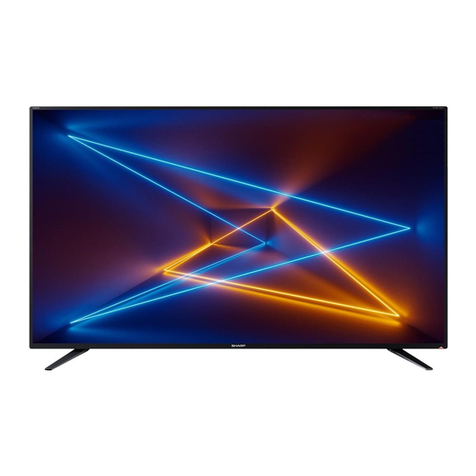
Sharp
Sharp A1/LC-55UI7252K operating instructions

Horizon Fitness
Horizon Fitness DIAMANT 22HL5300F operating instructions

Metz
Metz 55MOC9010Y Disassembly instructions
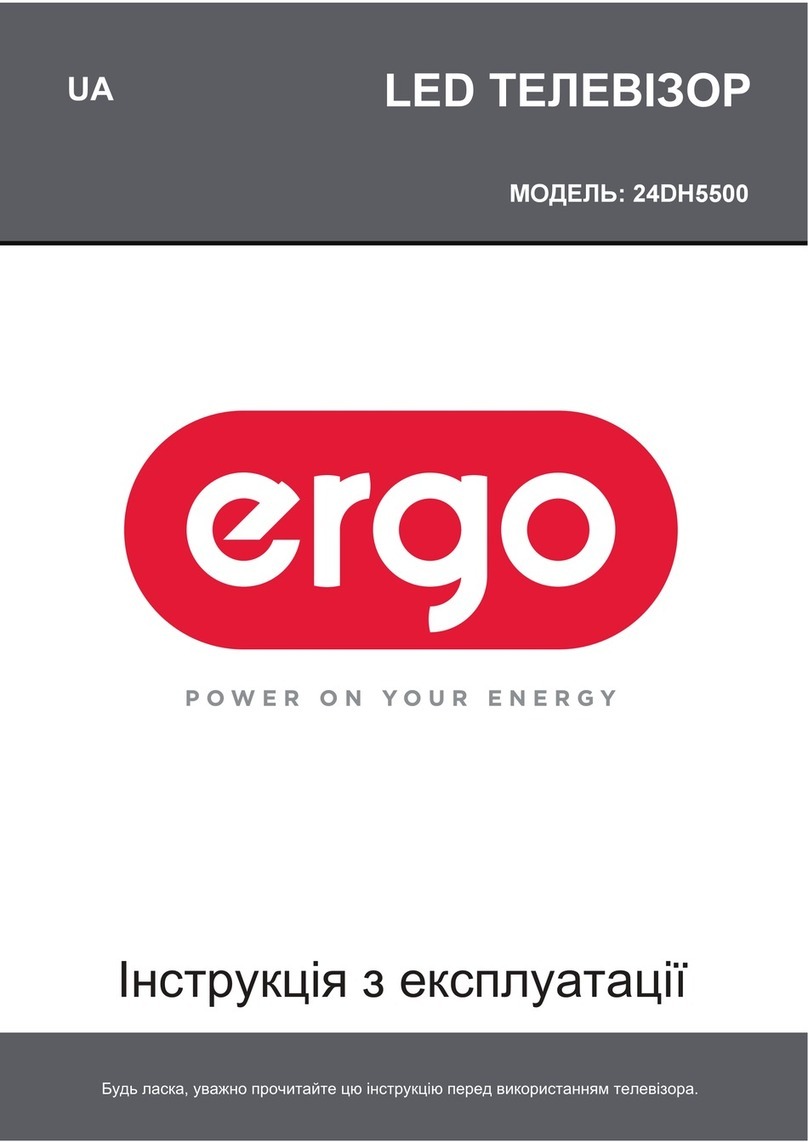
Ergo
Ergo 24DH5500 user manual

Changhong Electric
Changhong Electric UD55YC5500UA Operation manual
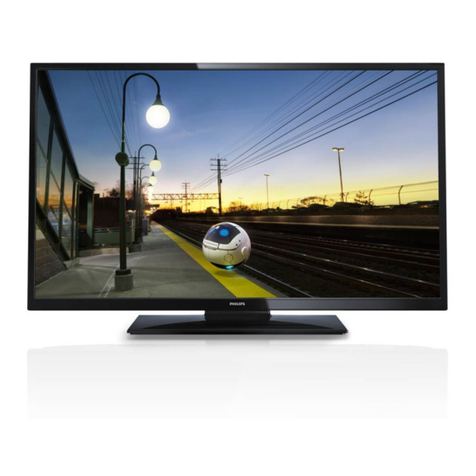
Philips
Philips 40HFL2829T/12 installation manual
